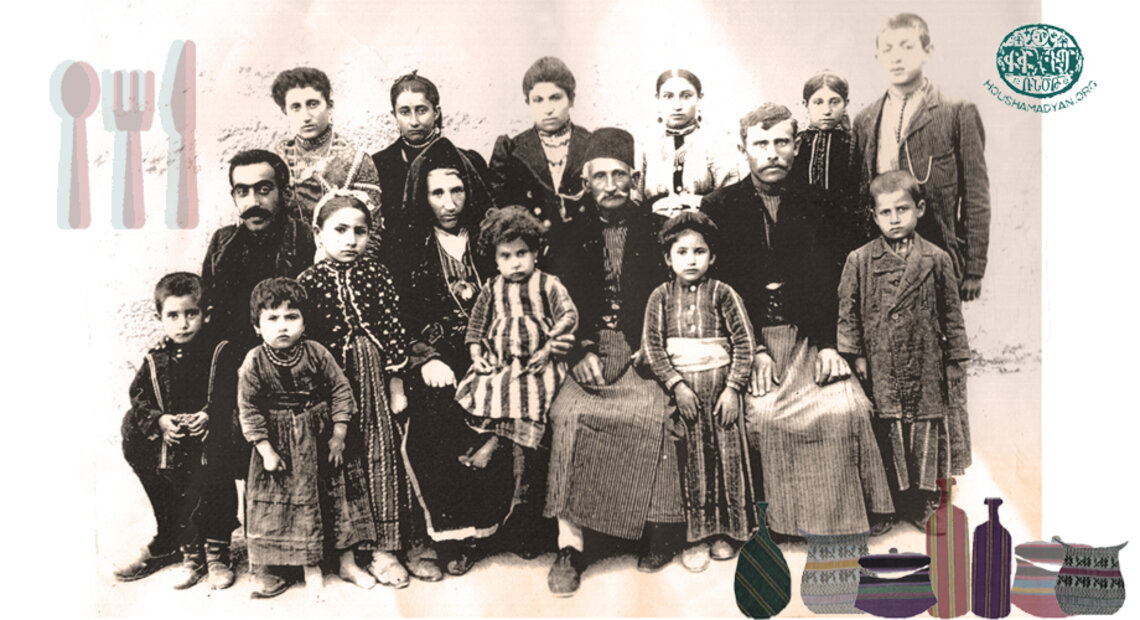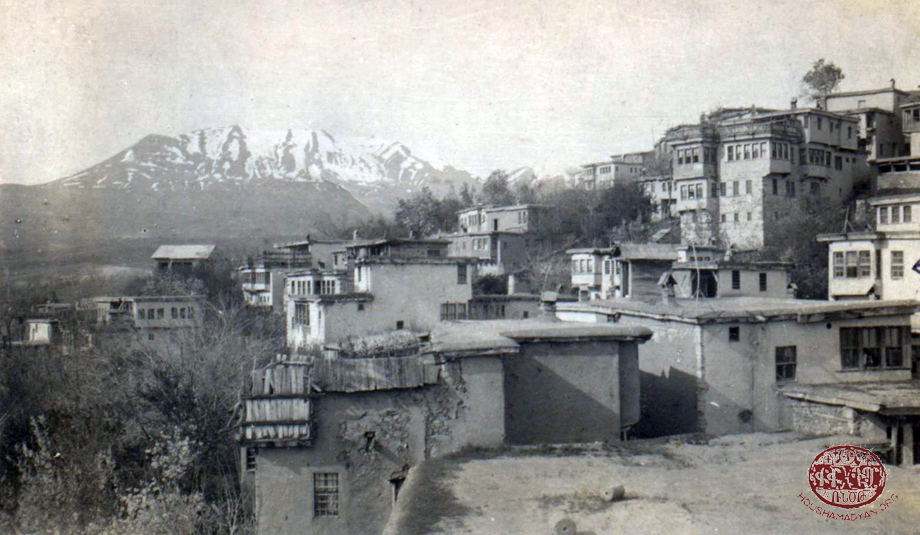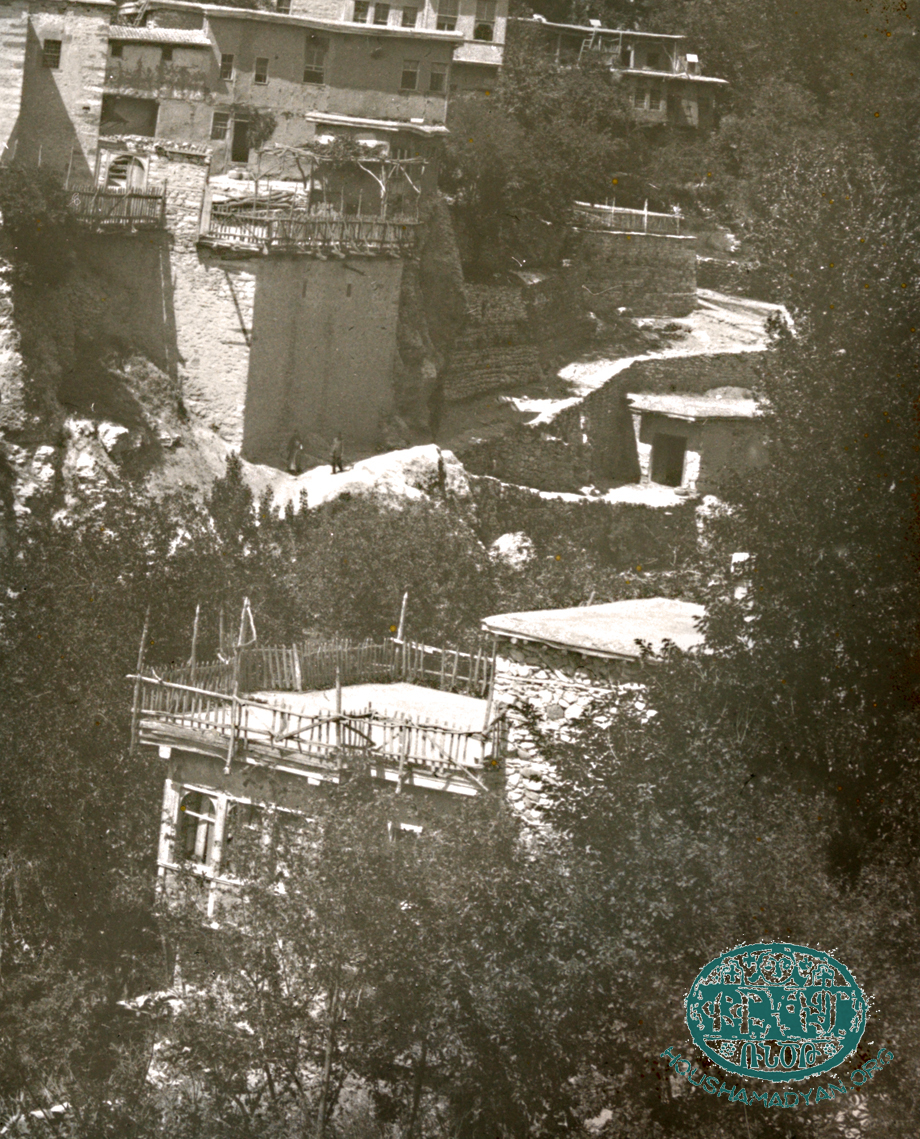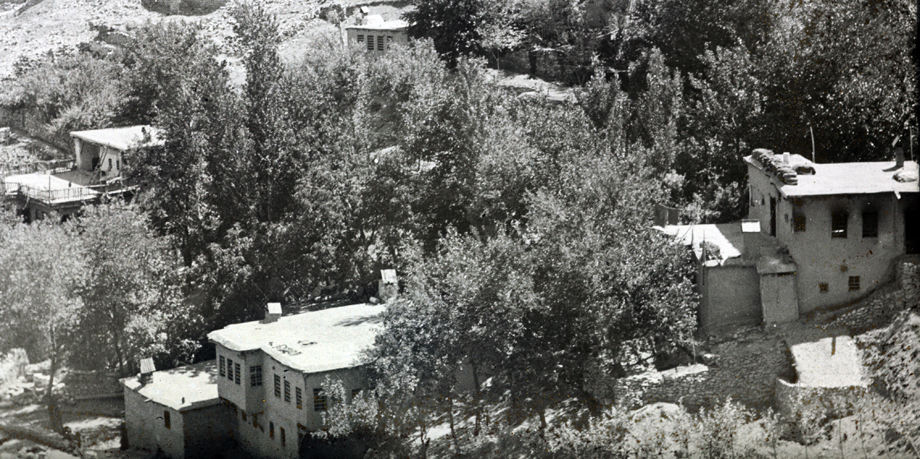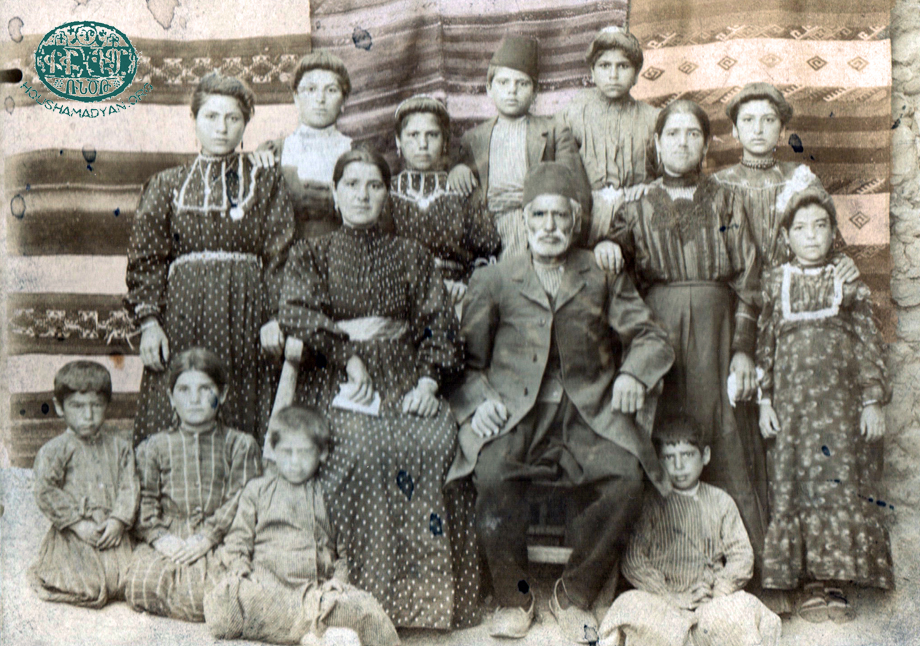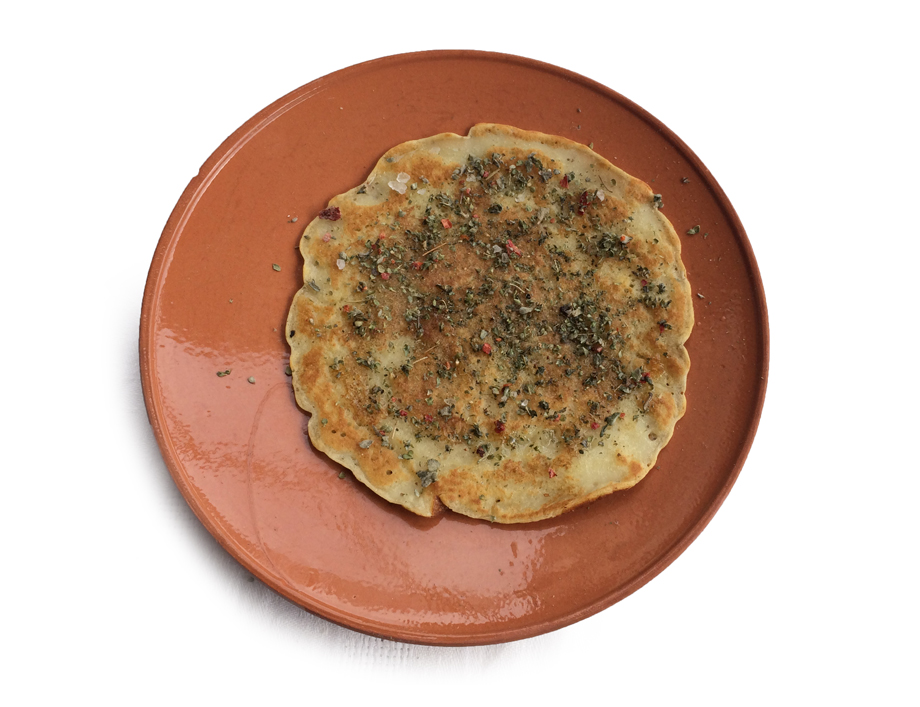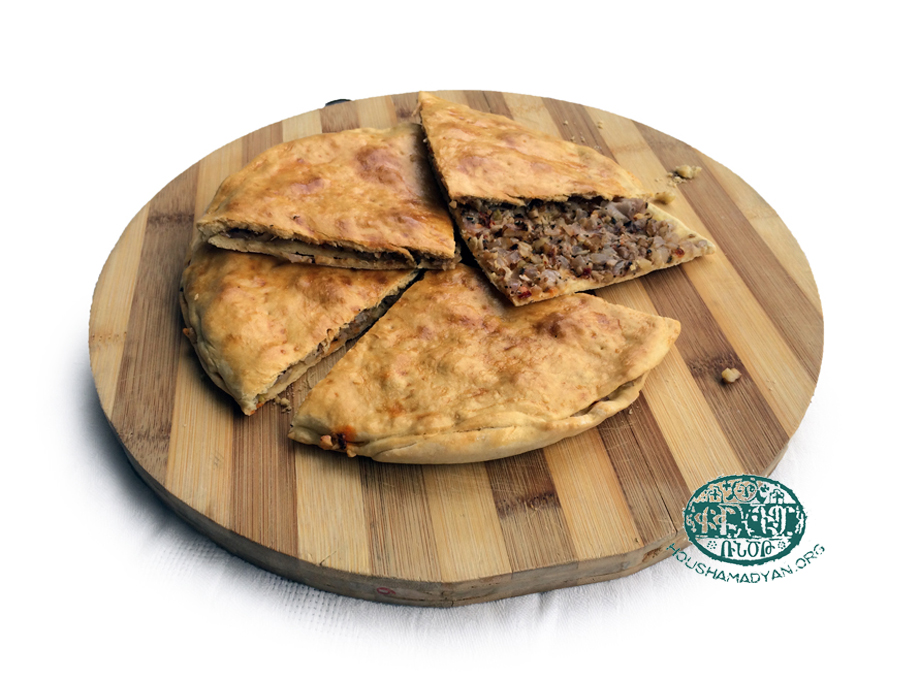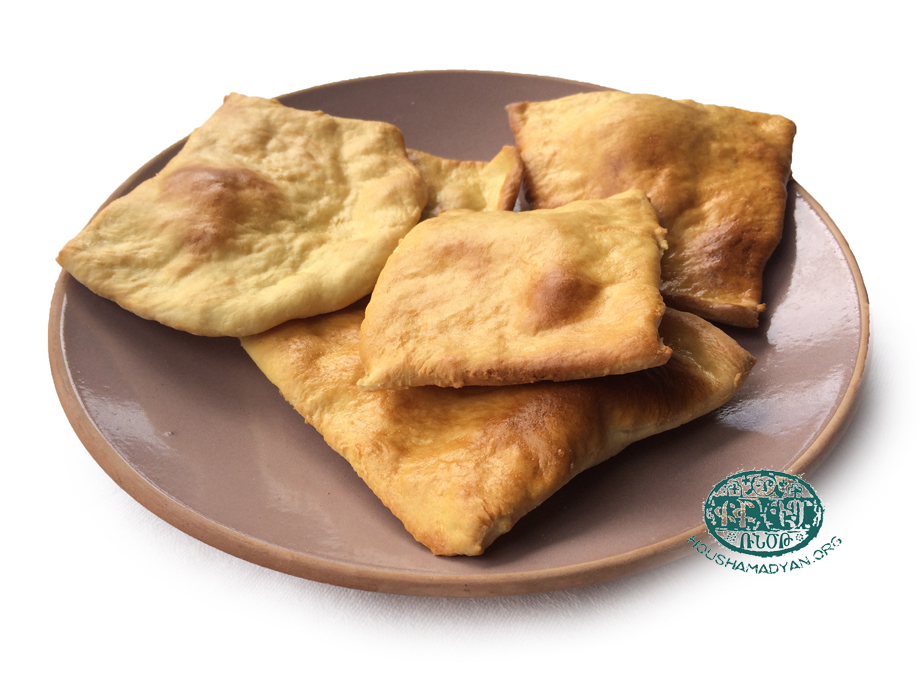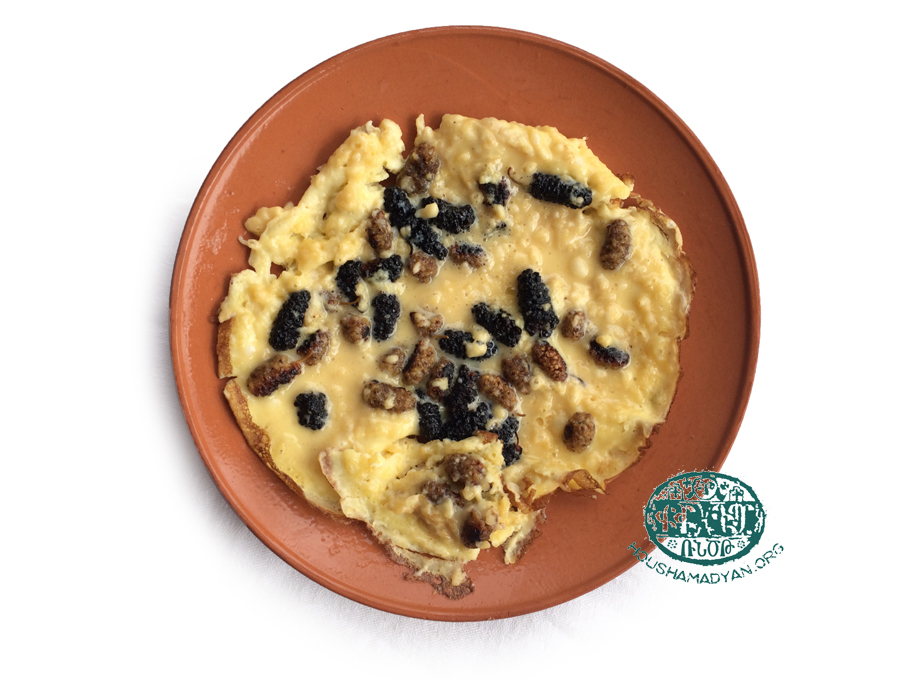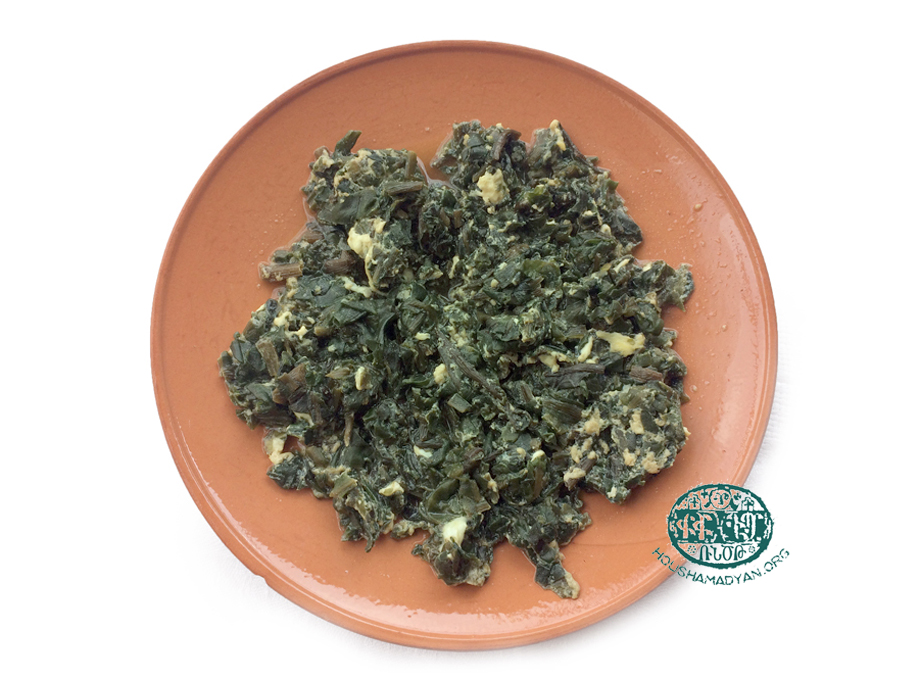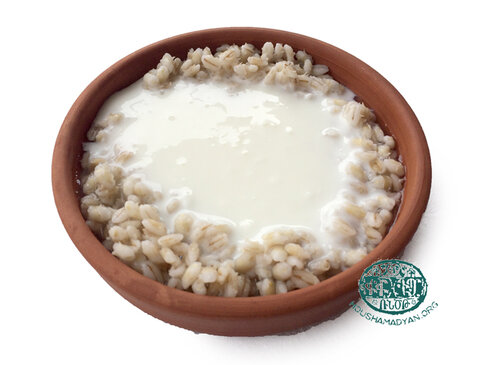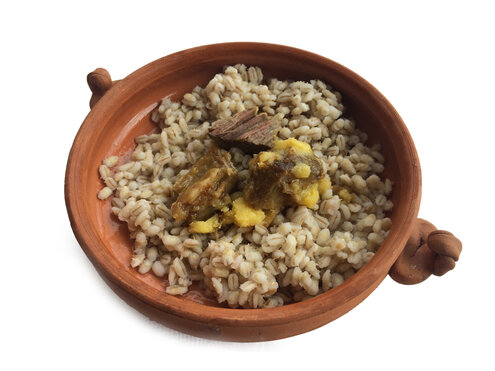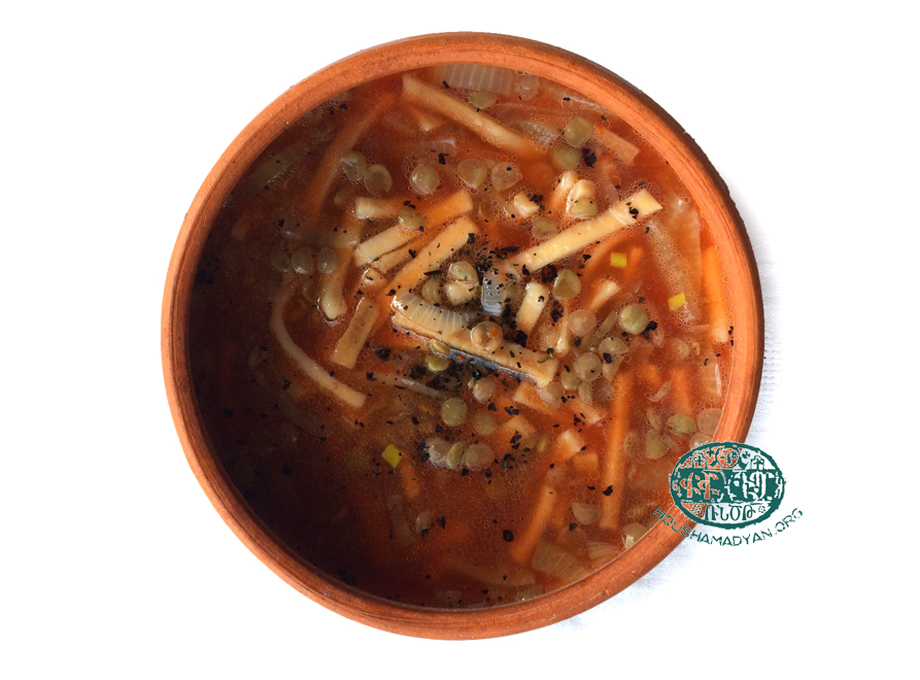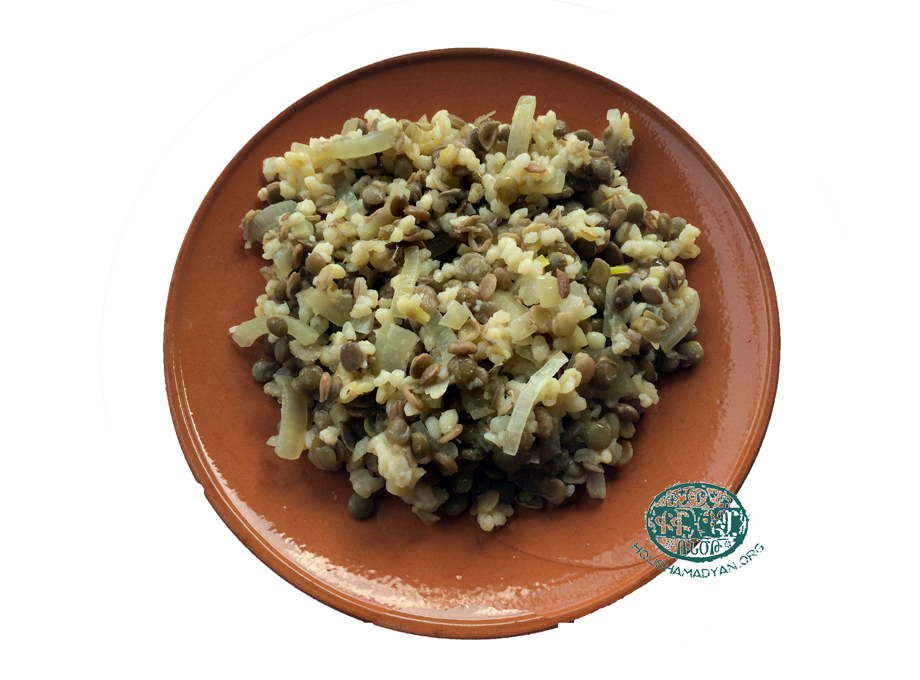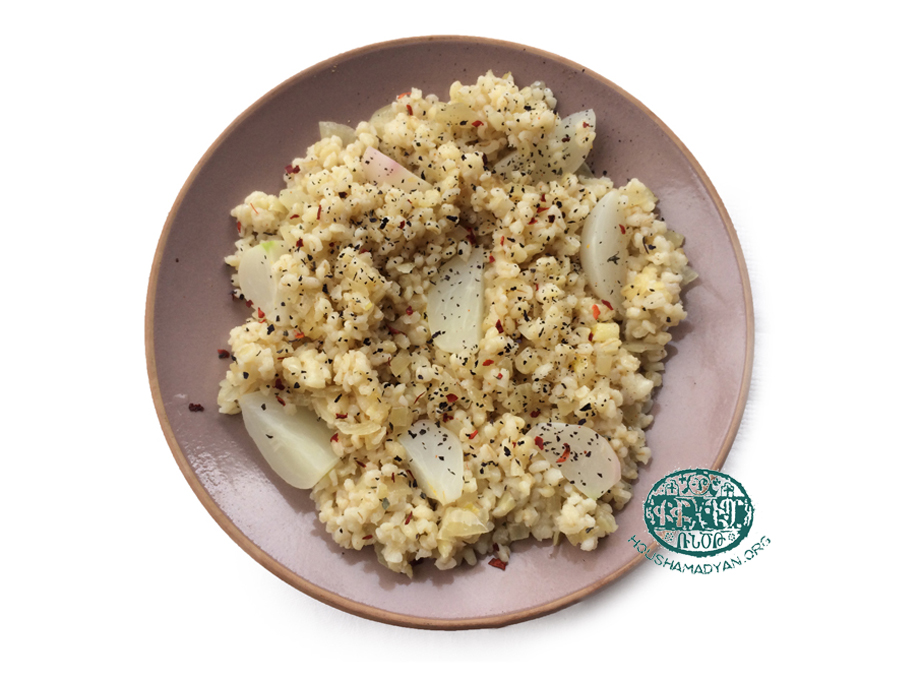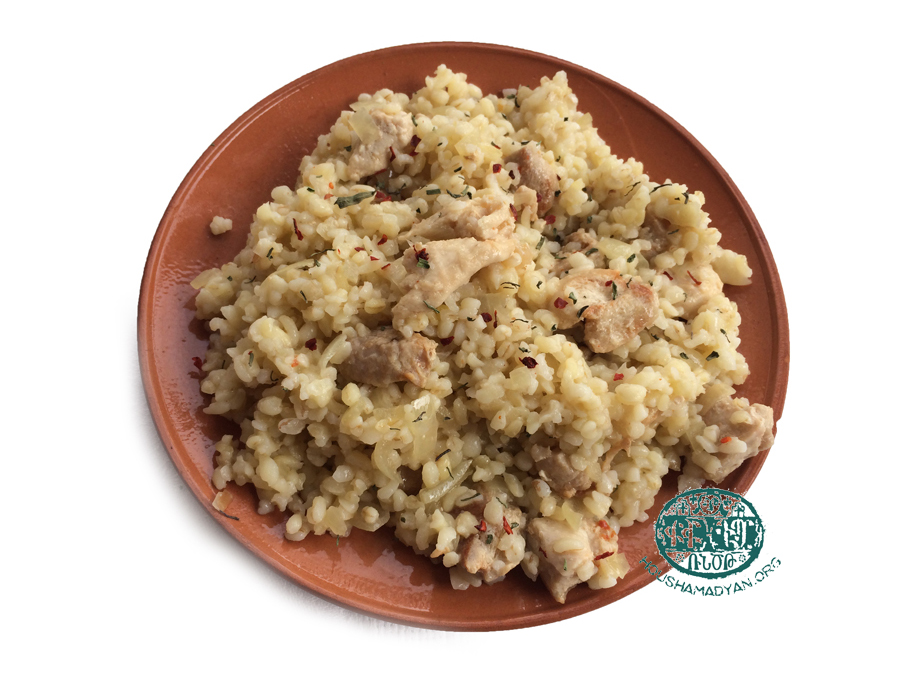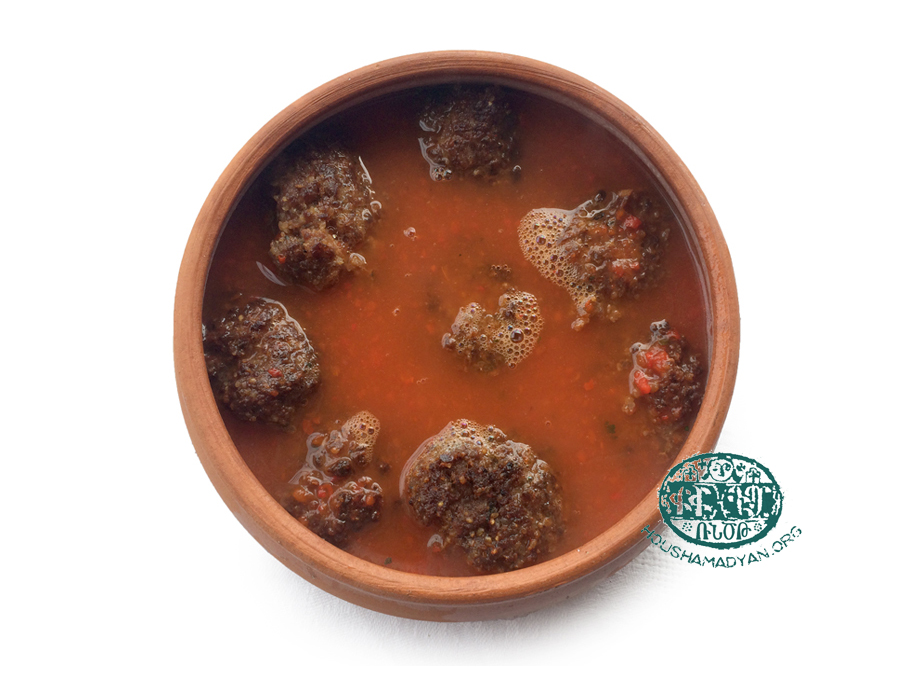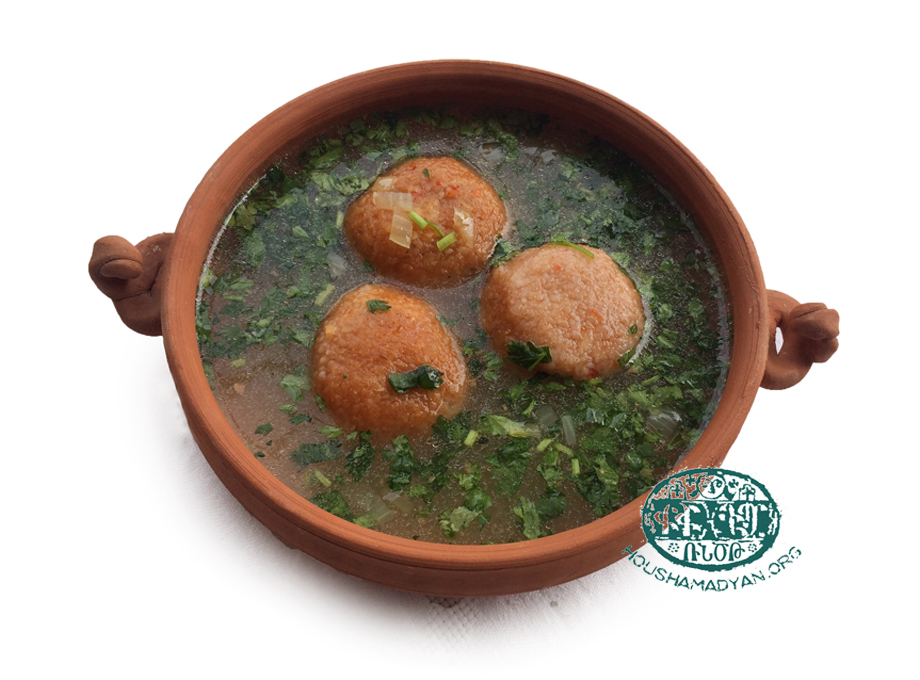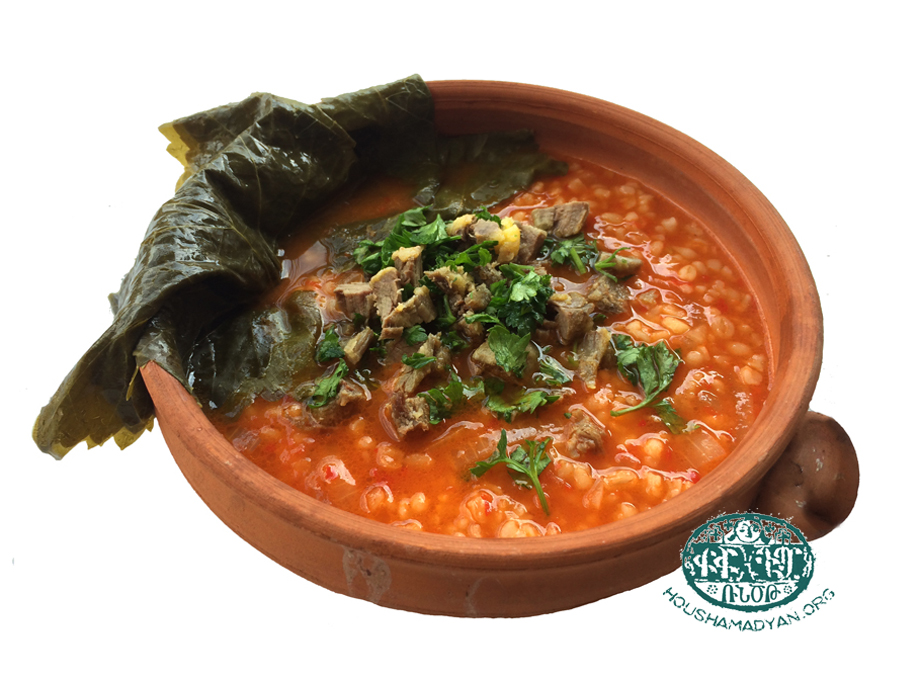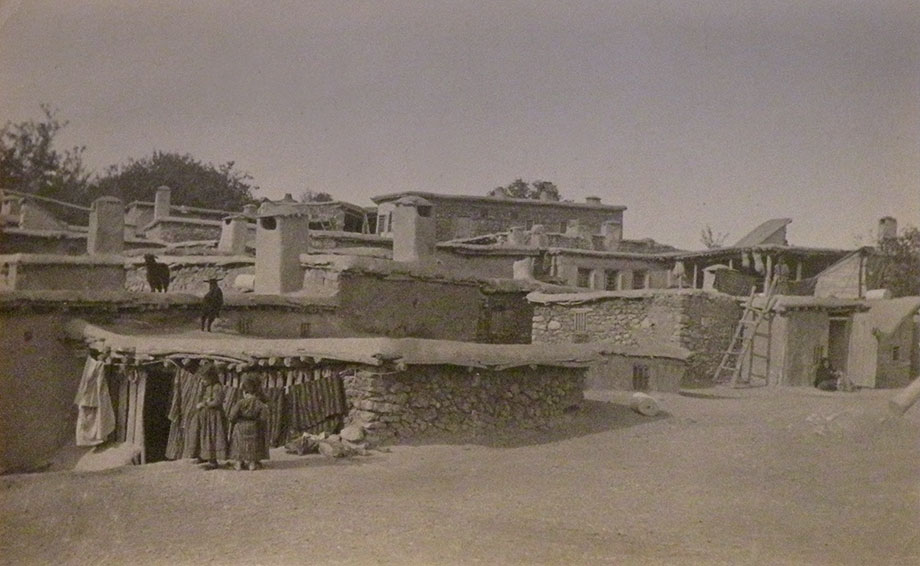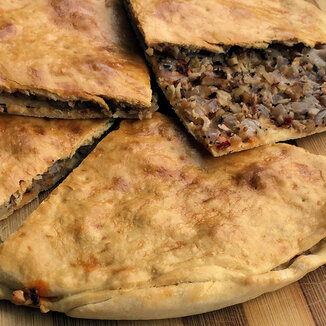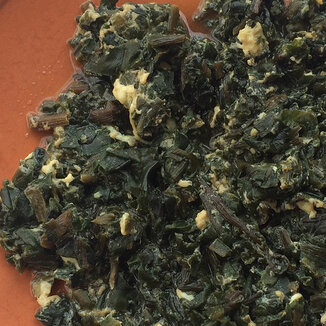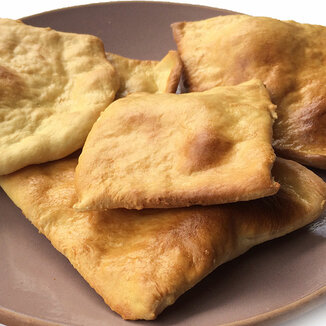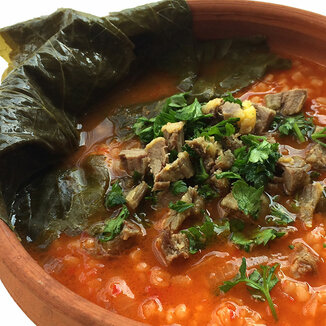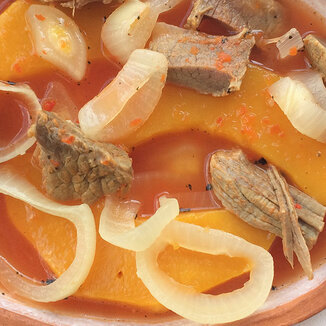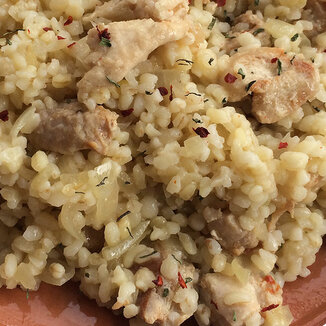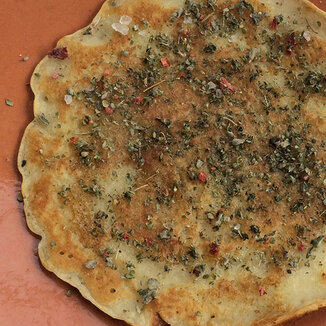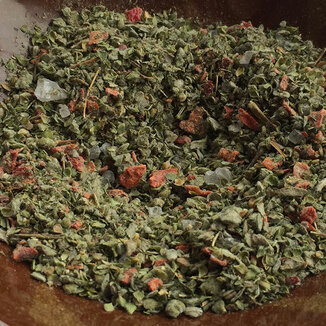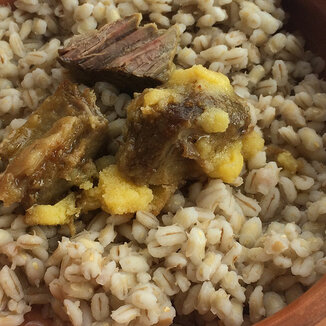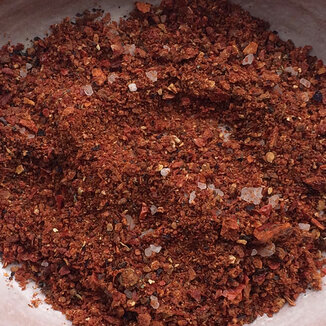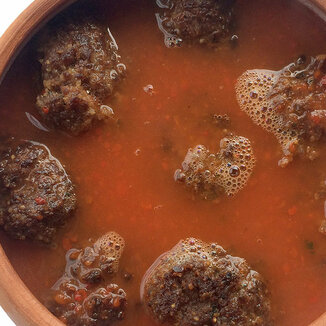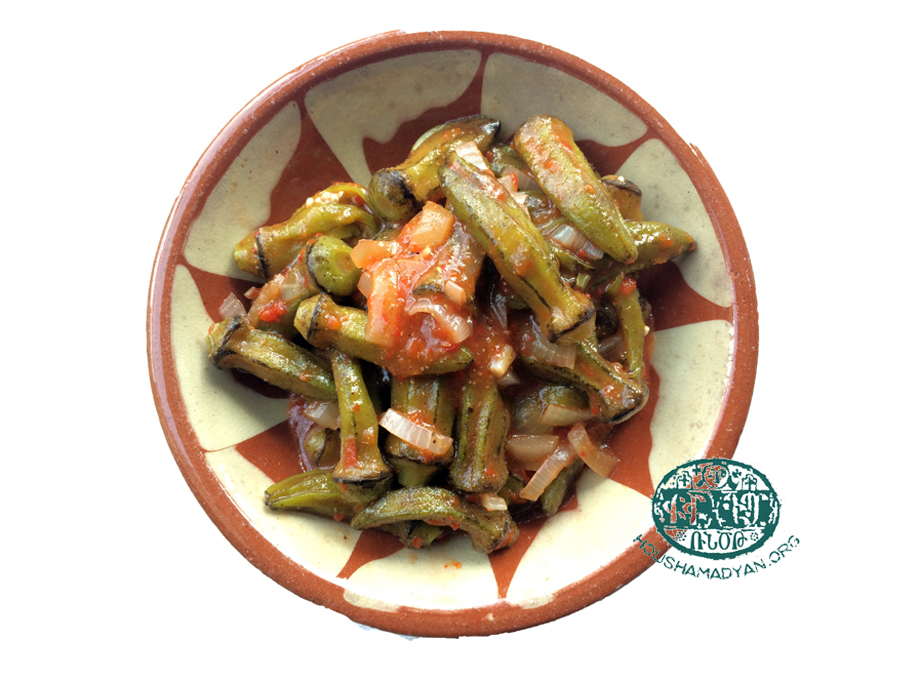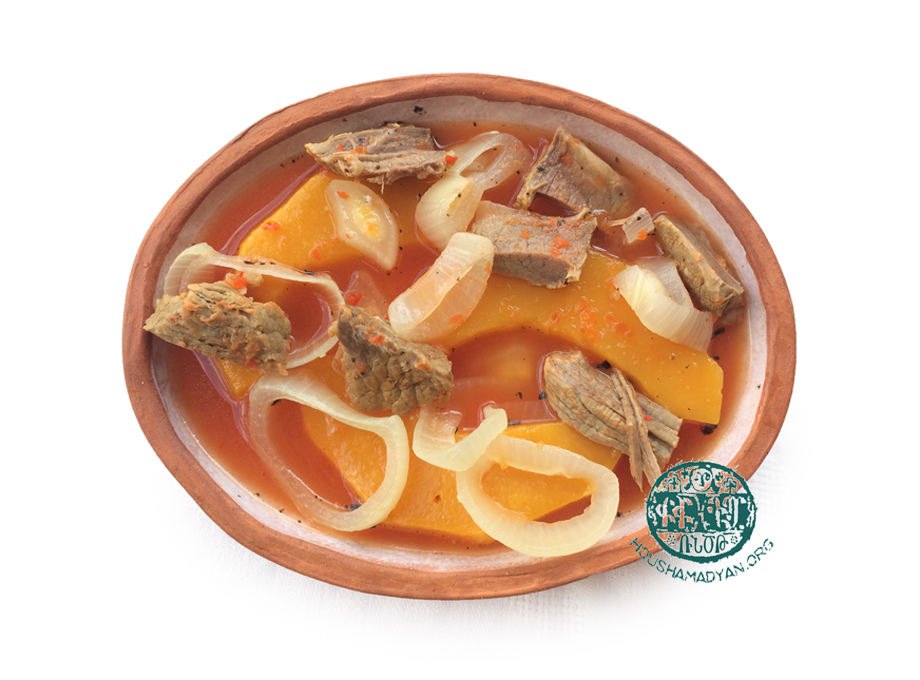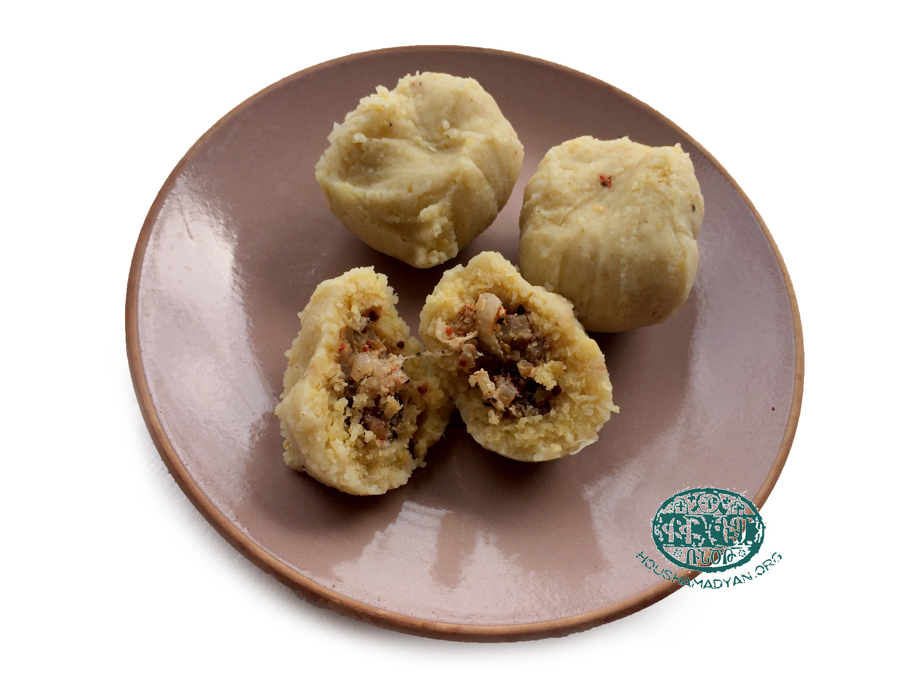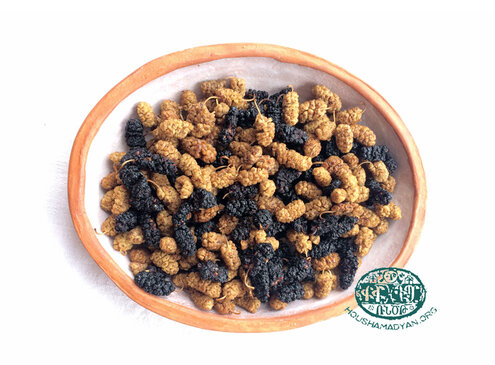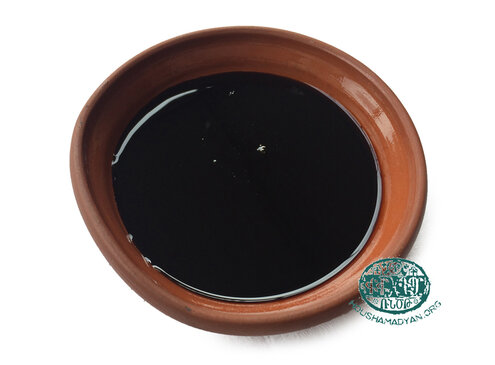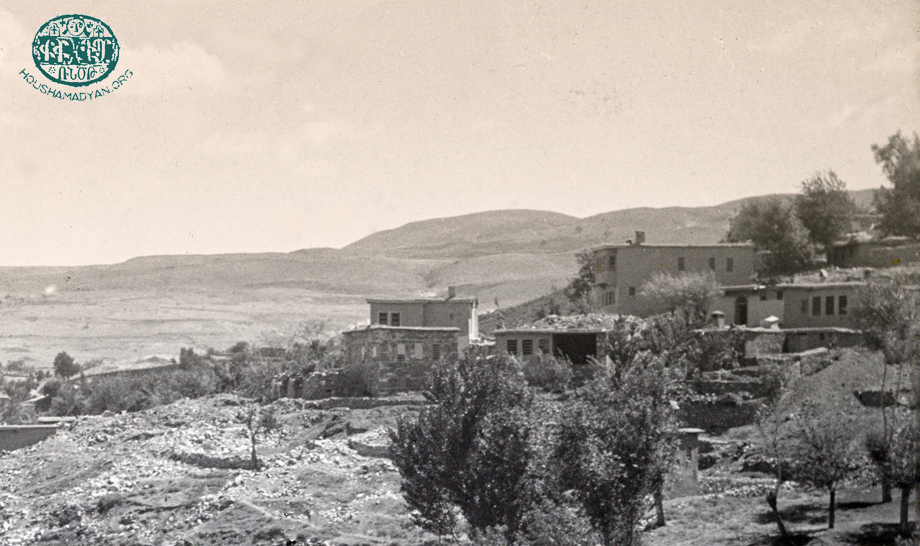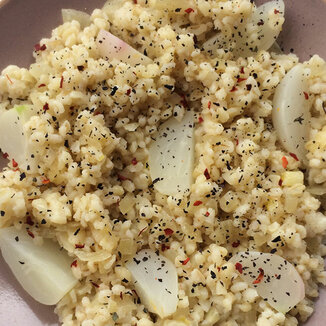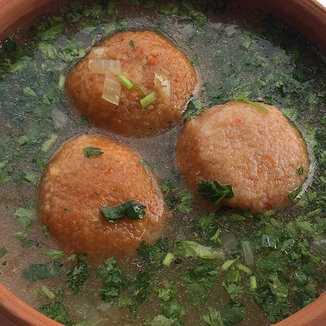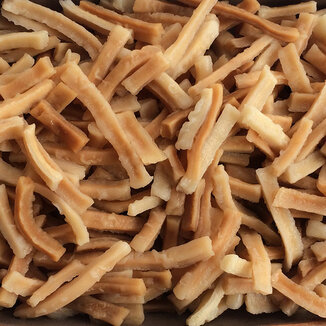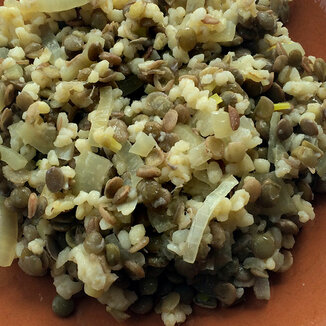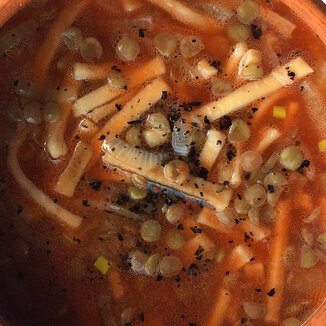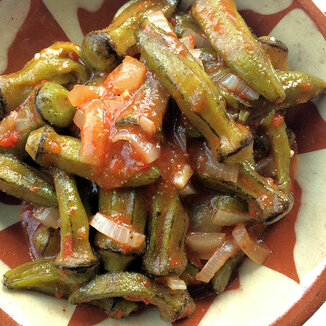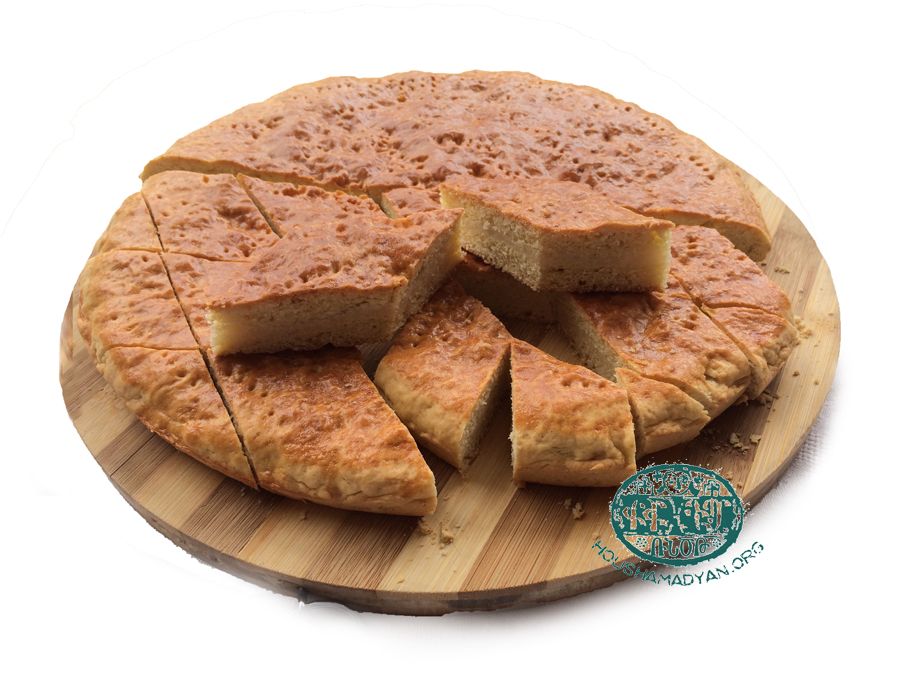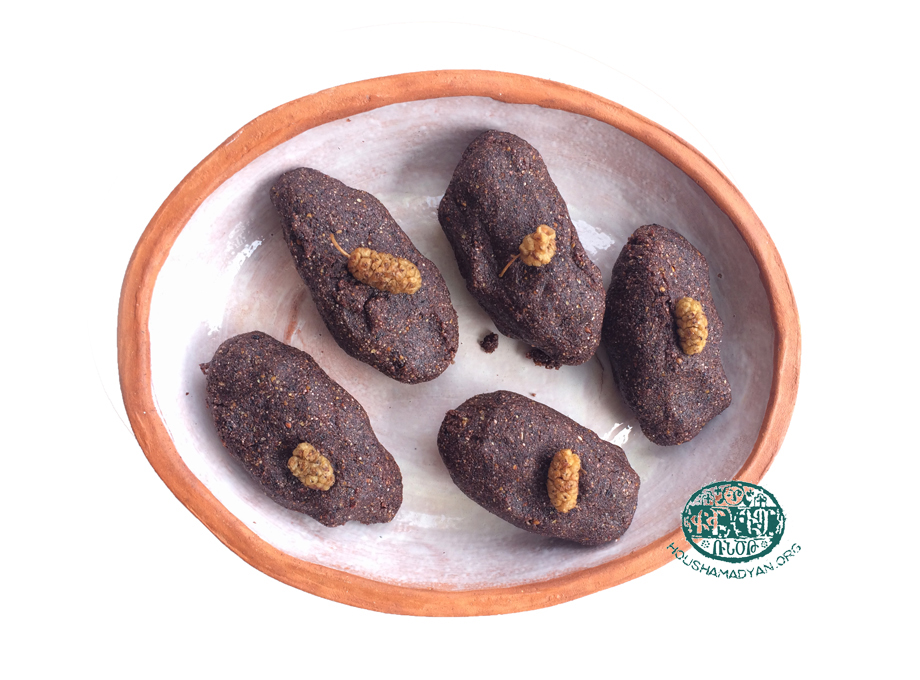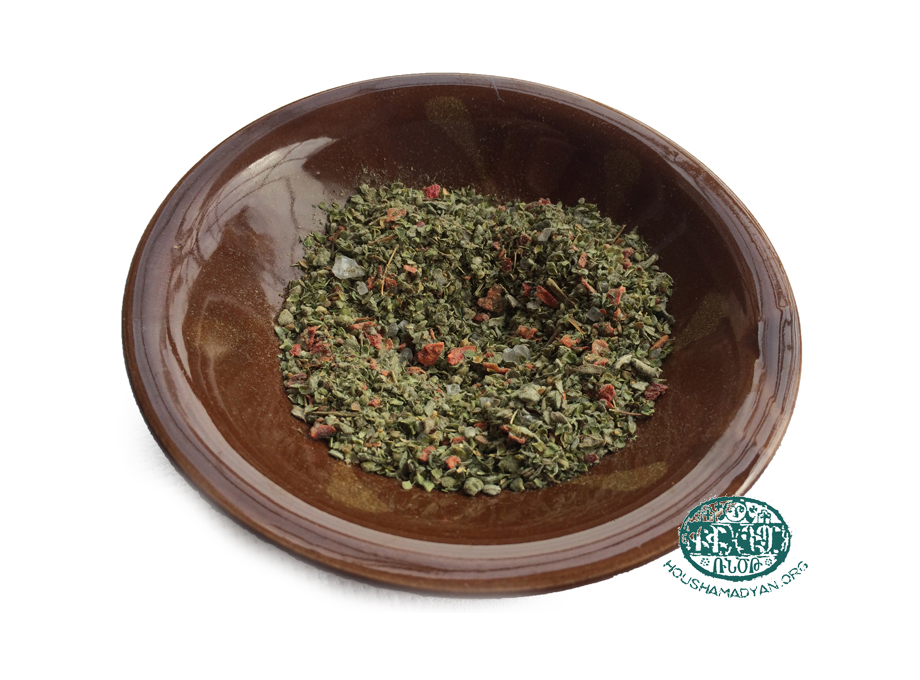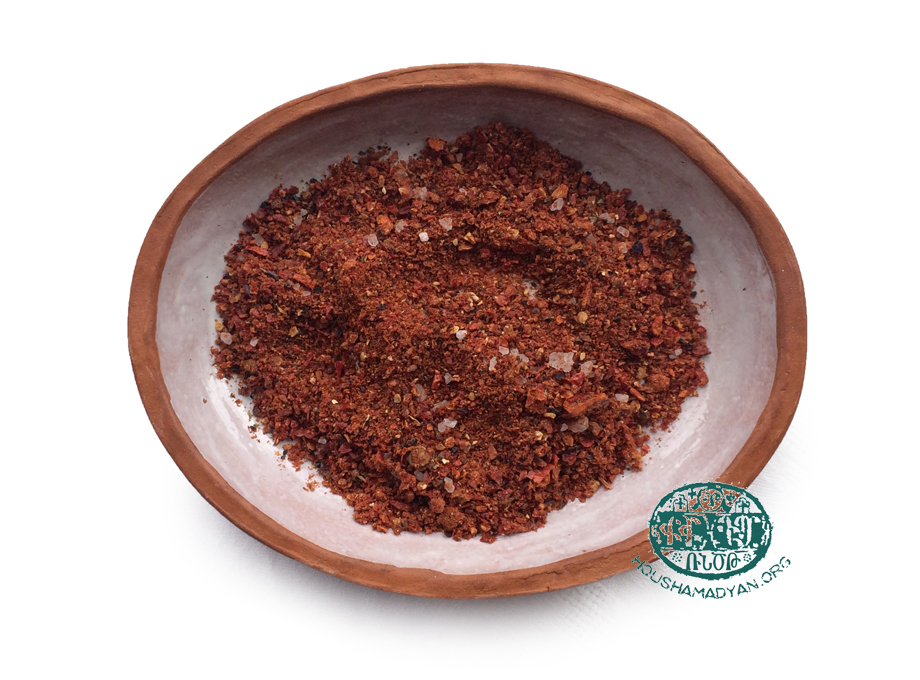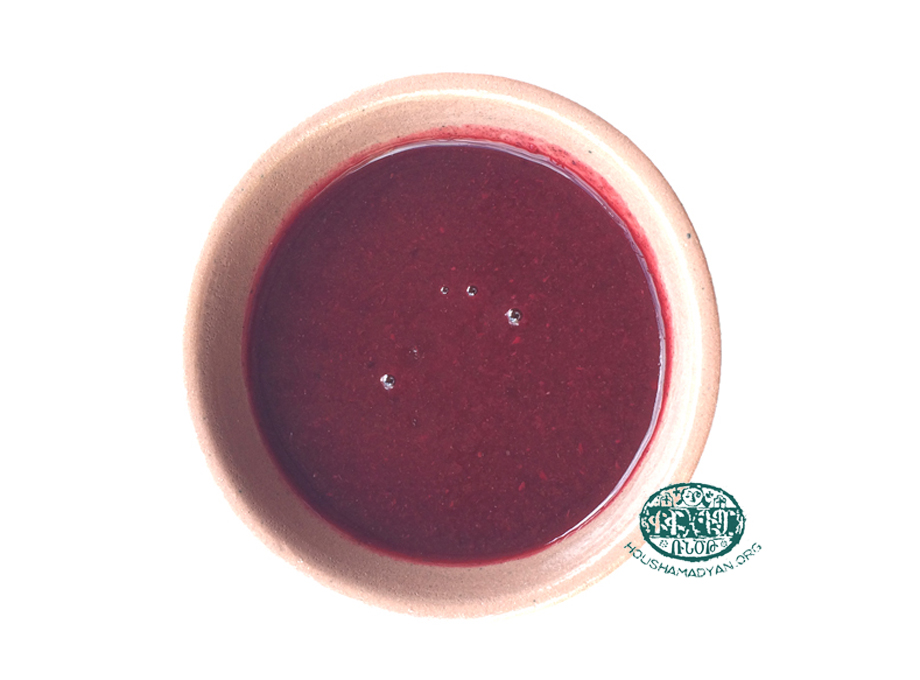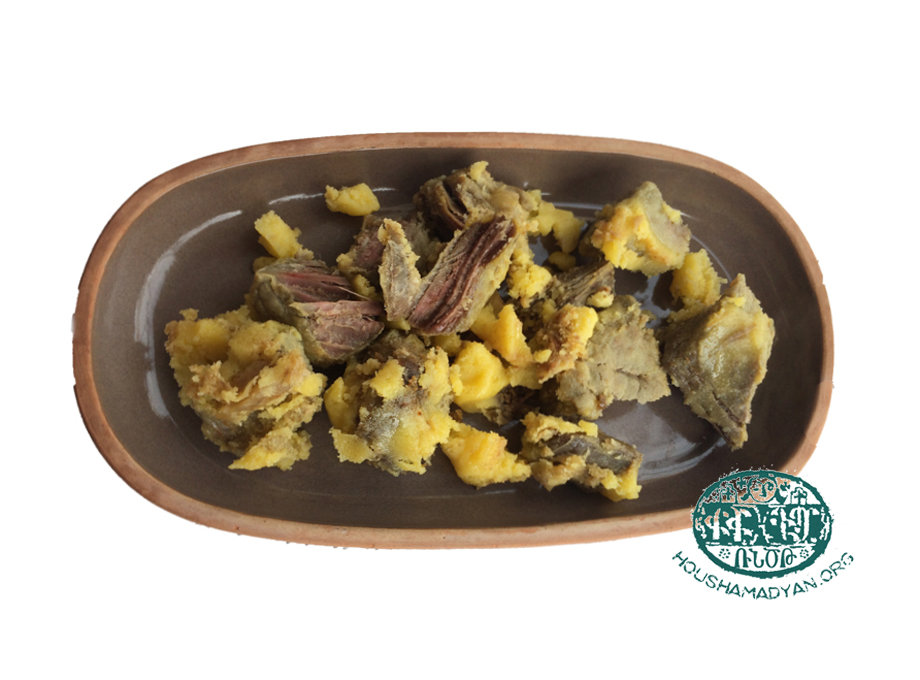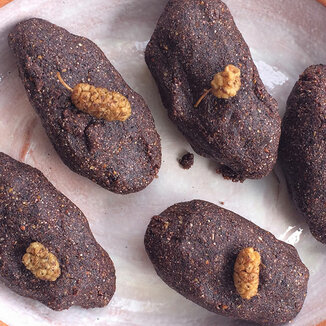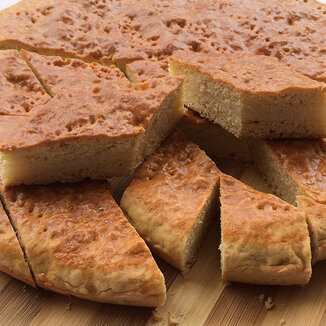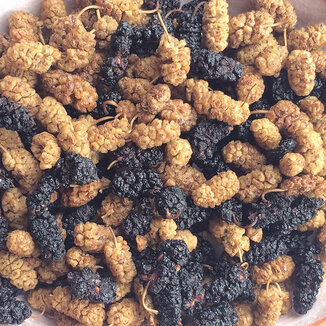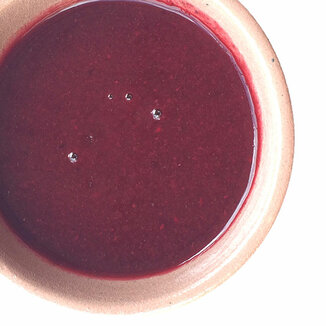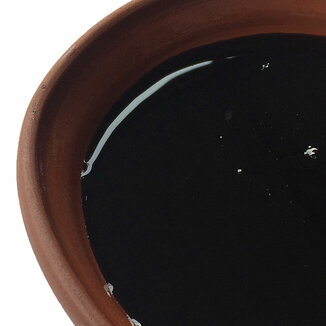Arapgir - Foods

Istanbul, work [is] plentiful;
Harput, cotton [is] abundant;
In Arapgir, bring to eat. [1]
That is how the fun-loving Arapgirtsi characterizes Arapgir's lifestyle: In other words, to live in the city of Arapgir, one must bring in sustenance from elsewhere.
However, according to its geographic attributes, the natural climatic conditions of Arapgir as a whole are temperate. Located 1250 meters above sea level, the Arapgir subdistrict (Ottoman kaza) lies on a plateau through which the Euphrates river runs; moreover, numerous rivulets flow from the mountains, flooding the subdistrict's fields, and so it's fair to say that water distribution is good. [2] The waters of the Vosgekedag are used to not only irrigate fields on the riverbanks but also to operate watermills along its course.
Located at the foot of the Taurus mountains, and protected by the mountain range, the Arapgir subdistrict has a relatively favorable climate: hot, but not humid summers; and cold winters with abundant snow. The mountains are forested, and the cultivation of trees for lumber (poplar, willow, oak) is widespread; the fields and mountainsides are suitable for sowing and planting.
Although Arapgirtsis are primarily tradesmen, agriculture is also well developed there, and they cultivate various fruits, vegetables, and cereal crops. Particularly renowned are the varieties of grape and mulberry, which they preserve and use throughout the seasons of the year in addition to exporting them and the products made from them, including raisins, grape molasses, fruit leather, fruit jams, and dried fruits. Also abundant are pomegranate, apricot, peach, fig, cherry, sour cherry, plum, pear, apple, quince, oleaster (wild olive), and hawthorn (azarole) trees, along with watermelon and melons, a portion of which they export to other cities to bring in revenue for the family; among nut threes, walnut, almond, hazelnut, and viburnum; among vegetables, beans, okra, squash, eggplant (aubergine), cabbage, carrot, radish, red and white beet, onion, garlic, cucumber, tomato, pepper, potato; among greens and herbs, they cultivate basil, mint, parsley, celery, dill, and chard (beet greens); among wild vegetables ,they gather cardoon (artichoke thistle) and wood-sorrel (oxalis); among wild herbs, thyme, savory, and wild mint (horsemint); and among cereals, the cultivation of wheat, barley, oats, lentil, chickpea, corn, beans, linseed, and sesame is prevalent. The village of Ehne, which is on irrigated land, grows rice and cotton. And it's likely that the name of the village of Hasgni (or Hatsgni) is derived from the words hats (bread) and gini (wine), which are the main products of the village. [3]
Meat animals are provisioned from Erzurum, although each family, according to its means, keeps chickens and milking animals—cows, sheep, and goats—in the plot of land adjacent to its home. At the end of autumn, each family prepares ghavourma (pieces of braised and preserved meat), pasterma (highly seasoned and air-dried cured beef), and soudjoukh (a dry, spicy cured sausage: sujuk) as ways of preserving meat for the winter.
To prepare cheese, they collaborate with neighbors, agreeing to take possession of the milk in turn, aided by a measuring stick made of grapevine wood. The tradition of exchanging milk is called khab. The accumulated milk is made into yogurt, which is poured into the earthen pot of the churn; after sealing it, they churn it by rolling the pot on pillows. They make butter, then clarified butter or ghee, and from the remaining diluted yogurt (tan) they obtain curds. They prepare a few types of cheese, including brined white cheese, which is hard cheese in chunks, and (leather-) bag cheese, or chekelig, which is churned in a leather bag and kept for winter. And, sometimes, milk cream is formed into small balls and dried for the winter. From yogurt they also prepare tarkhana (fermented and/or dehydrated yogurt or curds combined with egg and flour or bulgur) and chortan (pressed, dried yogurt, milk solids, and curds). [4]
The courtyard of each home has a firepit, barn, and often also a tandoor oven and oven shack. The houses are two-storied, with a stair-like structure: The earthen roof of the first story creates a small patio, which they call a chardakh, across from the rooms of the second story; that's where the house inhabitants sleep under the open skies in the summer. It's also an area suitable for drying tarkhana, fruit leather, pounded wheat, bulgur, pasta, fruits, etc. Usually, the woodhouse and storage cellar are in the basement level. [5] The kitchen (ashkhane) is on the first floor, in a separate room with pantries built into the walls and a pointed, arch-shaped hearth, the chimney of which rises to the roof. Along the walls of the sitting room (genaldun) they build in a meter-wide wooden platform (sedirne) as a place to sit or recline; usually, it's covered in carpet-like woven cloth, but on festivals or holidays they cover it with thicker, woolen rugs and arrange hay-filled pillows. The dining table is round and low to the ground, around which low-sitting small chairs are arranged. [6]
In the cellar (mehsen) is a large wooden storage closet in which baked and dried breads are arranged. Cereals and legumes—wheat, pounded wheat, bulgur, chickpeas, beans, lentils, etc.—are stored in leather sacks or earthenware containers (poghogh) arranged side-by-side. Preserved cheese, macaroni pasta, clarified butter (ghee), salted meat, ghavourma, sheep knuckles for pacha (a type of trotter soup), dried salted fish, various pickles, and grape leaves are kept in large casks. In smaller casks are kept rechel (fruits suspended in thickened molasses), mulberry molasses, grape molasses, tahini, etc. Hung from the ceiling are sujuk and pasterma; strands of dried beans, okra, pepper, eggplant, and squash; and bunches of wild and cultivated herbs and greens. In chests and boxes of various sizes are kept dried fruits, (including) raisin and mulberry, and fruit leather; various seeds, including squash, melon, and cucumber; nuts, including walnut, almond, hazelnut, and apricot stones. In the boxes arranged on shelving along the walls spices and ground herbs are kept, including red pepper, black peppercorn, basil, parsley, fenugreek (chemen), sesame seed, black seed (nigella sativa, or black cumin), and so on. Arranged on woven reads, or in baskets (zambil), or under salas (large basket, for keeping food underneath) are the cold-resistant fruits, such as pear, apple, quince, and pomegranate; and among vegetables, radish, onion and garlic, carrot, cabbage, squash, turnip, eggplant, potato, etc. Alcoholic drinks have a special place, including various types of wine and distilled spirits, as do, characteristically, a selection of medicines and salves and ointments. [7]
The menu of the Arapgirtsi is plain: Breakfast, at 9 AM, usually consists of milk and bread and cheese, and sometimes in-season fruit (incidentally, in-season fruits and greens are daily present in homes). The midday meal is simple—for example, fried eggs, grape molasses, and cheese. After vespers, all members of the family gather around the dinner table; the house elder recites "Our Father" (the Lord's Prayer), and they begin to eat their daily meal, such as boulghour abour (bulgur pilaf), accompanied by tan (diluted yogurt), greens, and onion. On Sunday, they inevitably prepare a meat dish. On holidays, that plain menu expands, becoming abundant and varied. For example, on Mardi Gras/Shrovetide, alongside the other dishes they prepare gatnabour (sweet porridge made with milk and rice); on Easter, freshwater fish, rice pilaf, egg piaz (a type of salad, made with oil and parsley), etc. Often, tanabour (yogurt and bulgur soup) is the meal eaten when working in the fields; it is kept in a parch (an earthen water pot or jug) and kept cold in the waters of a spring. When the season for work in the fields ends, the landlord takes meat and liquor to the fields to honor the workers with a celebration. [8]
Bread
Wheat and bread are the staple foodstuff of Arapgirtsis, as they are for all the populations of the region. Arapgirtsis collaboratively harvest and thresh the ripened wheat from the fields. They boil a portion of the wheat in tashons (large, copper-plated metal basins), then dry it by spreading it out on the roof, thus preparing gantma (bulgur) for harisa (porridge of meat, usually lamb, and wheat slowly cooked in cauldrons), porridges, and pilafs; and another portion they grind to make bulgur of various sizes; however, they take the largest portion of the wheat to the watermills for conversion into flour, accounting for approximately 250 kgs per person, per year. In Arapgir, ordinary tandoor (touyn) bread is round, with a 50-60 cm diameter and a thickness of 0.5 cm, which they bake 2-3 times per year, then dry for storage in the cellar; when it's time to make use of it, they soften it by sprinkling water on it. [9] They also have sadji hats (sadj bread), which they prepare with the same dough and roll out to the same size, but which they bake on a griddle (a domed piece of metal called a sadj); they place the sadj on three stones of equal size, build a strong fire underneath, then successively bake the previously stacked loaves, first on one side, then the other. Karahats is also baked on the sadj, but the dough is watery and unleavened; the woman of the house pours 8-10 dollops from a small ladle onto the sadj; that bread is eaten warm or cold after spreading sweets or sprinkling ground savory (satureja) on top. Aside from homemade breads, there is also the market or bakery bread—a 30-40 cm diameter gusgoudz (toasted, well-baked) appetizing bread. It's baked and sold in the bakeries at market; per the customer's request, before baking they also break an egg on top, or smear it with salty butter, or place pieces of white cheese on it. [10] And the bread called kouloudja, prepared with sesame, is a small ceremonial bread, which they prepare for weddings, to use as an invitation to the wedding. [11]
Shepig (present-day Yaylacık, one of the villages of Arapgir), Paregian/Parigian family, 1913. From left to right: Gadar Paregian (née Kaprielian), Vartanoush Maloomian (née Ayrasian), seated Gadar's mother-in-law and Abraham's second wife Khatoun Paregian (née Baghdassarian), Lucy (Khatoun's daughter), Hagop (Khatoun's son), seated Gadar's father-in-law Abraham Paregian, Elizabeth (Hoosqui’s daughter), Hoosqui (Khatoun’s sister), Shnorhig Ayrasian (Vartanoush’s sister), and Ashaloos (Hoosqui’s daughter). In front: unknown Shepik child, unknown Shepik child, Barnog (Khatoun's son), and Oskyon (Khatoun's son). This photograph was taken in 1913 and was sent to Abraham's son, Garabed, in America - based on the inscription on the back. Garabed was Gadar's husband. Only three people shown in the photograph survived the Genocide. (Source: Margaret (Paregian) Shaphren collection, Santa Rosa, CA)
Types of Bread
Bdjig
1 tablespoon ghee
1 cup yogurt
Half teaspoon baking soda
1 tablespoon vinegar
1 cup flour
Salt
Combine the yogurt, baking soda, salt, and vinegar; add the ghee and flour, and whisk; with a small ladle pour into a pan and bake on both sides. Dzahin bdjig is the name of the bread on which ground savory is sprinkled before eating. Similarly, they sprinkle "red savory" (ground dried tomato, basil, and hot red pepper) on bdjig.
Sokhov hats (onion bread)
Baked on a sadj, this bread is characteristically eaten during Lent. On meat (nonfasting) days, it's stuffed with leather-bag cheese and onions. [12]
For the dough:
2 cups flour
1 cup warm water
2 tablespoons dough starter
2 tablespoons oil
1 teaspoon sugar
1 teaspoon salt
For the filling:
2 onions
0.5 cup of walnuts
Ground red pepper
Dried basil
Salt
Knead the dough, and let it rest for two hours. Chop the onions and walnuts, then season. Separate the dough into two balls and roll them out with a rolling pin; place the filling in the middle of one of the dough rounds, cover it with the second round, reinforce the edges; bake on the sadj or in a frying pan, or in the oven.
Desmet
2 tablespoons of ghee
1 egg
1 cup milk (or yogurt)
2 teaspoons of dough starter
2-3 cups flour
Salt
Combine the ingredients, knead it, and let rest for two hours. Roll it out to a 1 cm thickness, cut into 7x7cm squares, brush with egg, prick the surface of the dough, and bake in an oven. Serve with cheese or sweets.
Djumour
Taking the hot bread from the tandoor, they tear it into pieces and pour clarified butter over it, break it up it with their fingers, and consume it; sometimes, depending on personal taste, they top it with brined cheese or grape molasses while eating.
Types of Frittata
Frittatas are diverse, including sweet and savory/salty types.
Dabgots (Fritter)
Chop up mulberry fruit-leather, dip in beaten egg, fry in ghee.
Mulberry frittata
Sauté dried mulberries in ghee, pour beaten eggs over them, and cook.
Frittata with Greens
Sauté chopped parsley and green onion in ghee, pour beaten eggs over it, and cook.
Frittata with ghavourma
Fry small pieces of ghavourma in its own fat, pour beaten eggs over it, and cook.
Mkhlama frittata
This type of frittata refers to eggs cooked with ghee-fried green beans, spinach, or tomato. [13]

Types of Dolma
Arapgirtsis have three types of dolma: meat and grape leaves; summer dolma, with meat; and Lenten dolma. They mince the meat with large knives or pound it on a flat stone designed for that purpose, which they term salkar ("anvil stone").
Dolma
Half a kg of ground (minced or pounded) fatty meat
2 cups large bulgur
2 onions
Half a cup of tomato paste
Fresh parsley and mint
Ground red pepper
Dried basil
Salt
Mix the filling ingredients, role them up into grape leaves, arrange them in a pot and fill with enough water to cover the dolmas, then cook over a low fire.
Summer dolma consists of the filling stuffed into eggplant, (summer) squash, peppers, tomato, or onion, or wrapped in grape or cabbage leaves.
Lenten dolma
2 cups large-grain bulgur
3 onions
0.5 cup tomato paste
0.5 cup oil
0.5 cup mulberry molasses
0.5 cup prunes
Fresh herbs/greens
Ground red pepper
Dry basil
Salt
To the sautéed onions (sokhrats) add the bulgur, minced herbs/greens, the tomato paste, and the mulberry molasses; season and wrap in grape leaves; when arranging them in a pot, intersperse prunes among the dolmas. Fill with enough water to cover the dolmas, place a tray or plate directly atop them, and cook over low fire until all the liquid is absorbed; let cool, then remove the dolmas so that they don't collapse.

Types of Pilaf
Arapgirtsis call pilaf abour ("stew" or "soup"); and they call stew or soup, shorva. For the most part, the pilafs are daily fare, but there are also holiday pilafs with meat. (Translator's note: abour can also be translated as porridge, which—like pilaf—is made with a cereal boiled in water (or milk), albeit porridge contains more liquid, whereas in pilafs the liquid is fully absorbed.)
Bulgur abour
1 cup bulgur
2 cups water
2 onions
2 tablespoons ghee (or oil)
Ground red pepper
Dried basil
Salt
Pour the bulgur over sautéed onions, then the water, and season; cook until the water is absorbed.
Ptig or dznig abour
Ptig refers to the most finely ground bulgur, with which the homonymous pilaf is prepared.
1 cup finely ground bulgur (semolina)
1 cup water
2 onions
1 tablespoon ghee
Ground red pepper
Dried basil
Salt
Pour the bulgur and spices over sautéed onions, then add the water and cook until the water is absorbed.
Pasta (erishta) abour
Boil the pasta and drain it; serve it hot, topped with ghee. Offer tan or garlic-yogurt on the side. The pasta that's intended for pilaf, unlike ordinary pasta, often has eggs mixed in the batter, which is why it's not dried for preservation.
Osbok (lentil) abour
2 cups lentil
2 cups water
1 cup coarse bulgur
3 tablespoons ghee
Ground red pepper
Dried basil
Salt
Boil the lentils then drain; add the bulgur and sautéed onions, add the water and seasonings, and cook until the water is completely absorbed. Serve with turturchour, a drink made specifically for this meal: 1 cup mulberry molasses diluted in 5 cups of water, to which is added chopped parsley, smashed garlic, and dried basil.
Abour with ganduma
2 cups bulgur
0.5 kg of ghavourma
3 tablespoons of ghavourma fat
3 onions
Ground red pepper
Dried basil
Salt
Boil the bulgur; Sauté the ghavourma and onions; add seasoning and pour it on the bulgur; cook five more minutes and let rest. Serve with tan.
Pancharabour (abour with chard)
0.5 kg of chard
1 cup bulgur
2 cups water
2 onions
2 tablespoons ghee
Ground red pepper
Dried basil
Salt
Boil the chard, add the bulgur then sautéed onions and seasonings and oil, and cook until water is absorbed.
Chirabour (abour with dried fruit)
Prepared with dried apricot or prunes, boiled with bulgur or chickpeas; it's eaten warm, with salt sprinkled on top, without ghee added to it.
Supurdoug
1 cup rice or coarse bulgur
0.5 cup erishta
2 cups water
2 tablespoons ghee
Salt
Boil the rice (or bulgur); brown the erishta in ghee and add it to the pilaf while it's still cooking, when the water hasn't been completely absorbed; continue to cook on low fire. [14]
Ghallen
A type of Lenten food prepared with coarse bulgur and radishes, it's topped with onions sautéed in oil, then served. Porani is also prepared the same way, but with squash or beetroot (instead of radish).[15]
Khapourgha
0.5 kg of boiled chicken (or ghavourma)
3 tablespoons of ghee
3 onions
2 cups coarse bulgur
4 cups stock (broth)
Ground red pepper
Dried basil
Salt
Cut up the chicken or ghavourma and fry in its own fat, add chopped onion, then bulgur; sprinkle with dried basil and ground red pepper; add the stock and cook until the liquid is absorbed.
Madagh ("Offering/Sacrifice")
They prepare the madagh pilaf with rice or coarse bulgur; adding chunks of chicken or lamb on top, they take it to church, for distribution at the entrance of the church. [16]
Abour with tan
Boil bulgur, serve with cold, thick tan.

Types of Soup/Stew
Tanesbas
Prepared by boiling churn tan with flour paste, adding boiled bulgur, then cooking.
Top soghan
1 kg small onions
300 gm of ghavourma
2 tablespoons of ghavourma fat
2 tablespoons of tomato paste
Juice of 1 lemon
Ground red pepper
Dried basil
Salt
Stew the cleaned small onions together with the chopped ghavourma meat, fat, and tomato paste. Add the water, ground red pepper, and dried basil. Squeeze as much lemon juice on top as desired. Serve with bulgur pilaf.
Gldrig Shorva
For the gldrig (small meatball disks):
0.5 kg of ground meat
0.5 cup of medium bulgur
1 tablespoon tomato paste
Ground red and black pepper
Dried basil
Salt
1 tablespoon of ghee, for frying
For the broth/soup:
2 liters of water
2 tablespoons tomato paste
Ground red and black pepper
Dried basil
Salt
Mix the gldrig ingredients; knead with wetted fingers and form mixture into walnut-sized balls, flatten into disks, then fry them. Boil the water for the broth; add the paste and seasonings, then the meatballs, and cook.
Kofta with filling
For the shell:
0.5 kg pounded (ground) meat
0.5 kg fine bulgur
For the filling:
300 gm of onion
300 gm of walnut
1 tablespoon ghee
Ground red pepper
Dried basil
Salt
For the broth:
2 liters of stock
1 onion
Fresh parsley
Black pepper
Mix and work the meat and fine bulgur. Add chopped walnuts and seasonings on sautéed onions. Prepare round and flat kuftas (meatballs), then boil in stock; turn off the heat and add chopped onion, parsley, and black pepper to the broth.
Derevchour ([grape] "leaf water")
For the broth:
2 cups coarse bulgur
8 cups water
0.5 cup tomato paste
0.5 cup mulberry molasses
2 tablespoons ghee
Ground red pepper
Dried basil
Salt
For the topping:
0.5 kg of ghavourma
2 onions
Fresh parsley
Other ingredients:
Brined grape leaves
Dried lavash bread
To sautéed onions add tomato paste, mulberry molasses, then the bulgur, seasonings, and water; cook. Chop up the ghavourma and mix in the chopped greens and onions. Serve individually; each person adds the ghavourma topping to the semi-watery bulgur porridge and eats it with dried lavash or preserved grape leaves.
Havgitchour ("eggwater") or chrivran ("atop water")
Boil water with some ghee and salt; boil chopped chard in it. Before serving, add beaten egg, stir quickly so that the egg doesn't coagulate. It's eaten with stale dried bread shredded into it. Yeghchour ("gheewater") is a similar soup, but without the chard; instead, onions sautéed in ghee are added to boiling water, then the beaten eggs are added. [17]
Ttouov havgit ("tart egg")
0.5 kg of eggplant
3 eggs
2 tablespoons ghee
0.5 cup of mulberry molasses
1 head of garlic
Salt
Slice the eggplant, dip in beaten egg, and fry. Add the remaining egg to the boiling water and stir quickly so that it doesn't coagulate; then add the eggplant, mulberry molasses, and garlic. Bring to boil once and serve with lavash.
Osbok shorva ("lentil soup")
In soups, khoriskhi malez—a roux of toasted flour and water—is often used.
1 cup lentils
0.5 cup flour
1 L water
3 onions
2 tablespoons ghee
Ground red pepper
Dried basil
Salt
Boil the lentils; add the flour diluted in cold water, sautéed onions, and season.
Osbok erishte ("pasta with lentil")
1 cup lentils
1 cup pasta
1 L water
2 onions
2 tablespoons of ghee
2 tablespoons of tomato paste
Ground red pepper
Dried basil
Salt
Boil the lentils; add the pasta, water, sautéed onions, and paste; season.
Tarkhana shorva
10 tarkhana pieces*
1 L water
2 onions
2 tablespoons ghee
Dried mint
Salt
Wet the tarkhana overnight. Cook over low heat, then add sautéed onions and mint.
This soup is usually prepared for bath days, to be eaten hot after returning from the baths.
*1 cup of bulgur and 2 cups of cooked yogurt can be substituted for the 10 pieces of tarkhana.
Makhokhabour
A Lenten soup, similar to tarkhana soup; however, whereas tarkhana is made with tan and bulgur, the pieces of makhokh (formed by squeezing the mixture in one's palm, like tarkhana) are prepared in the summer by boiling bulgur and mixing it with yogurt starter and flour paste. [18]
Ttou shorva ("tart soup")
After boiling tart prunes, they press them through a sieve, then while (again) boiling the pressed prunes they mix in water-diluted flour. (The Arapgir dialect has the word ttvishoghig for expressing the concept of a half-tart, half-sweet taste.)
Khoshab shorva ("compote soup")
A liquidy food cooked with chickpeas, raisins, and other dried fruits. [19]
Chickpea soup
2 cups boiled chickpeas
1 L water
300 gm of ghavourma
2 tablespoons of ghavourma fat
2 tablespoons of tomato paste
Ground red pepper
Dried basis
Salt
Add the sautéed onions, tomato paste, ghavourma, and seasonings to the boiled chickpeas; add water and cook.
Bean seed soup
2 cups of dried beans (seeds)
1 L water
3 onions
2 tablespoons ghee
Ground red pepper
Dried basil
Salt
Boil the beans, add sautéed onions and seasonings.
Stem soup
For this soup they use the stems of eggplants they've dried in the summer—hence the name. Before use, wash the stems and hydrate them in warm water.
0.5 cup beans
0.5 cup chickpeas
0.5 cup bulgur
0.5 cup lentils
20 eggplant stems
0.5 kg of small onions
5 dried red peppers
Dried basil
Salt
Soak beans and chickpeas beforehand; boil all the cereals/legumes and eggplant [stems] together in abundant water, in the process adding the onions and dried peppers and basil. Serve with pickle juice on the side (as a digestive drink).
Main Dishes
Msakhka (mousakka)
0.5 kg of ghavourma
1 kg potatoes
3 tablespoons ghavourma fat
3 onions
Ground red pepper
Dried basil
Salt
Cube and fry the potatoes and fill them into an oven tray; cover with a layer of chopped ghavourma, then layer that with sliced onions; add pepper and basil. Bake only a few minutes and serve hot.
Boumbar
First they clean out, wash, and salt lamb small intestines inside and out. Then they cut them into 20-centimeter-long pieces, and with the help of a funnel they insert the filling consisting of wetted bulgur flavored with onion and salt and pepper; they tie off the ends with string, boil them in a boudoug (earthen pot for cooking), and serve them hot.
Pacha (lamb trotter soup)
In Arapgir, pacha (khash) is prepared with lamb trotters (knuckles/feet). It's customary on the day after weddings or on Easter mornings to organize a pacha gatherings; those occasions are called pacha morning or pacha day. [20]
Eggplant dish
1 kg of small eggplant
3 heads of garlic
0.5 kg peppers
0.5 kg tomatoes
1 tablespoon butter
Oil for frying
Salt
Peel stripes along the length of each eggplant, dip the garlic cloves in salt and insert in the eggplant, then fry in hot oil. Also fry the peppers. Sauté sliced tomatoes in butter, then in the same pan line up all the vegetables, in order, cook on moderate heat, and serve.
Neck harisa
The conventional bulgur-harisa is prepared with rooster meat, whereas this harisa, customarily cooked on days when ghavourma is being made, is prepared with the neck meat of the butchered animal (usually lamb, rarely cow). It's cooked overnight in the tandoor, in hot ashes. It's served with ghee and ground red pepper.
Okra dish
0.5 kg okra
2 onions
2 tablespoons ghee
2 tablespoons tomato paste
2 tablespoons mulberry molasses
Ground red pepper
Dried basil
Salt
Add water to sautéed onions, then the paste, mulberry molasses, and seasonings; boil the liquid, add the okra, continue cooking. Serve with rice or bulgur pilaf.
Squash ghapasbasi ("covered stew")
1 kg squash
0.5 kg onions
300 gm ghavourma
1 L meat stock (broth)
0.5 cup mulberry molasses
Ground red pepper
Dried basil
Salt
Cut up the squash and onions in circular slices, arrange in a pot, sprinkling salt and basil in between the pieces. Two hours later, add the meat, broth, and mulberry molasses and cook together.
Topig
This type of dish is prepared especially on Lenten days. ("Topig" means small ball).
For the shell dough:
1 cup fine bulgur
1.5 cup chickpeas
1 onion
Dried basil
Ground red pepper
Salt
For the filling:
3 onions
1 cup chopped walnuts
0.5 cup toasted and ground sesames
2 tablespoons ground chickpeas
Dried Basil
Ground red pepper
Other:
2 cups flour
20x20 cm cotton cloths
Soak the chickpeas beforehand. For the filling, chop the onions, salt them, let sit to draw out the liquid, then drain; add the remaining ingredients. For the shell, grind the chickpeas, add finely chopped onions, the bulgur, and the seasonings, then knead, wetting the fingers. Take a palm-sized piece of the dough, make an indentation with a finger, fill it with filling, close up into a ball, roll in the flour; place it on the cloth and tie up the cloth into a bundle. When all the balls have been prepared, boil the bundles in brine. This food is prepared in large quantities, and served cold.
Khis
Unique to Arapgir, khis is a semi-watery dish served with garlic-yogurt. It's prepared with or without ghavourma meat.
Garlic khis
1 head of garlic
0.5 kg eggplant
1 tablespoon ghee
Ground red pepper
Dried basil
Salt
Stew the chopped garlic in the ghee, add the cut-up eggplant, add seasonings, and continue to cook. Serve with garlic-yogurt.
Chard khis
0.5 kg chard
2 onions
2 tablespoons ghee
Ground red pepper
Dried basil
Salt
Add the chard to the sautéed onions, add seasonings, and cook. Serve with garlic-yogurt.
Green bean khis
0.5 kg green beans
2 onions
2 tablespoons ghee
Ground red pepper
Dried basil
Salt
Add the beans to sautéed onions, add seasonings, and cook. Serve with garlic-yogurt.
Churchure khis
0.5 kg eggplant
2 tomatoes
2 peppers
2 onions
1 head of garlic
2 tablespoons ghee
Fresh greens and herbs
Ground red peppers
Dried basil
Salt
To the sautéed onions add the cut-up eggplant and tomatoes, pepper, fresh greens, dried basil, and a little water; continue to cook 5-10 minutes.
Squash churchure khis
0.5 kg squash
2 onions
2 tablespoons ghee
0.5 course bulgur
1.5 cups water
Ground red pepper
Dried basil
Salt
To the sautéed onions add squash cut into small cubes, stir and turn for a few minutes, then add the bulgur and water, add seasonings, and cook.
Types of Salad
Piaz with potato
0.5 kg boiled potatoes
1 onion
Oil
Fresh parsley
Salt-preserved celery and dill
Ground red pepper
Dried basil
Salt
Cube the potatoes, add sliced onions, chopped greens, and oil, then season.
Bean-seed piaz
2 cups boiled bean seeds
1 onion
3 tablespoons mulberry molasses
2 tablespoons oil
Ground red pepper
Dried basil
Salt
Add sliced onion to the beans, then water-diluted mulberry molasses and oil, and season.
Piaz with green beans
0.5 kg green beans
2 onions
Oil
Fresh parsley
Ground red pepper
Dried basil
Salt
Boil fresh or dried green beans, let cool; add chopped greens, oil, and season.
Piaz with eggs
This is prepared on Easter Eve and customarily eaten as a type of meal for breaking the Lenten fast, accompanied by the phrase "opening up of the mouth with piaz."
5 boiled eggs
1 boiled potato
Oil
Fresh parsley
Black pepper
Salt
Chop the eggs, potato, greens, onion, then add oil and season.
Purslane with yogurt
200 gm purslane
1 cucumber
0.5 L yogurt
1 clove of garlic
Dried mint
Salt
Lightly boil the purslane, then drain; add chopped cucumber, yogurt, and pressed garlic; season.
Purslane salad
0.5 kg purslane
2 cucumbers
Oil
Fresh parsley
Vinegar
Ground red pepper
Salt
Lightly boil the purslane, then drain; add chopped cucumber, parsley, and oil, then season.
Purslane salad with walnuts
Arapgirtsis greet the New Year with this salad; it must be the first bite they consume at the first moment of the New Year.
0.5 kg purslane
1 cup walnuts
3 cloves of garlic
Salt
Lightly boil the purslane, then drain; add chopped onions, salt, and crushed garlic.
Skhdorchour ("garlic water")
A type of dressing, prepared by crushing garlic in the skhdorkoush (a stone or wooden bowl for pounding garlic), then mixing in salt and vinegar. It's used usually for salads. [21]
Aghantz ("roasted")
Prepared on holidays by roasting bulgur, chickpeas, and corn on a low fire.
Sweets
Khashil ("boiled")
Arapgirtsis prepare this dish by dissolving ptig (fine bulgur) or flour, then boiling in water. They serve it with ghee; some offer it with grape molasses on top.
Ghavoud or khavidz
This nourishing dish, intended for nursing mothers, is also prepared on the holiday of St. Sarkis. Toast flour in ghee, add a little salt, then boiling-hot water; boil while continually stirring. Serve hot, along with a helping of grape molasses or honey. [22]
Hasirde, hasouta, or hishasda
1.5 cups farina
3 cups water
0.5 cup grape molasses or honey
0.5 cups ghee
Dissolve the farina in water, add the molasses and ghee while cooking. It's similar to a pilaf.
Herisa
Among the sweets of the Arapgirtsis, this comestible prepared with ghee, honey, and flour stands out. [23]
Khoshab
Select a small amount of all types of dried fruits, pour boiling-hot water on them, after boiling them a few minutes wrap them in a hot cloth and allow it to become macerated. Serve hot, warm, or cold, along with the dried fruits.
Pishi
2.5 cups milk
5 eggs
A pinch of salt
As much flour as the liquids will take
Melted butter
Make and knead the dough, and form into 10 palm-sized balls. Roll out thinly, brush butter, and fold unto itself. Bake in the oven or cook in pan, on low heat. Serve with grape molasses, honey, or rechel.
Glor ("round") kata
For the dough:
2.5/3 cups flour
0.5 cup ghee
0.5 cup sugar
3 eggs, plus 1 for eggwash
1 cup yogurt
1 teaspoon baking soda
1 tablespoon vinegar
Salt
For the filling:
1 tablespoon ghee
0.5 cup sugar
1 cup flour
Make and knead the dough, cover, and let rest. Mix together the ghee and sugar for the filling, adding the flour and working it with the fingers until it forms crumbles. Roll out the dough, spread out the filling in the middle, fold the surrounding dough over the filling [maintain circular shape], flatten it out, score designs on top, then brush with eggwash, and bake. For the filling, it's possible to leave out the sugar and add a little salt.
Halva
1 cup pokhintaliur ("polenta flour")
3 tablespoons grape molasses
1 tablespoon ghee
Knead the flour, ghee, and molasses and form halva pieces by squeezing them in the palm.
Usually, pokhintaliur is prepared by first roasting, then milling bulgur; instead of pokhintaliur, they also use the toasted flour remains that accumulate underneath the screens on which erishta/pasta is cooled. In Arapgir, they have a tradition of making halva with flour made of dried and ground mulberry that they also call pokhintaliur; when preparing halva with mulberry pokhintaliur, use only water and ghee for kneading, since the sweetness of the pokhintaliur is sufficient to sweeten the halva.
Preserved Foods
Artaregh (clarified butter, ghee)
Melt the butter, sprinkling some salt into it; heat for a long period over low heat, removing the foam that forms on the surface; when the liquid becomes clear, fill in a glass jar and store.
Chortan ("dried tan")
Create a mixture of strained yogurt, a little water, salt, and flour; prepare balls the size of walnuts, and lay them out to dry under the sun. To use, wet them with water beforehand in a langar (a copper or earthen pot), then mash them into a thick liquid.
Green dzahin (savory)
Dry wild savory, grind it, then season with ground red pepper and salt.
Red dzahin
Halve, salt, and dry tomatoes; then grind them and season with dried basil and ground hot red pepper.
Rechel
Dilute mulberry molasses and boil it; add washed and cut-up fruit, and cook 10-15 minutes. Leave under hot sun for 1-2 days; thereafter, place in jars and cover.
Mulberry bastegh (fruit leather)
Boil mulberry with a little water in a lagan (large, wide-mouthed metal tub or cauldron), continually stirring so it doesn't stick to the bottom. Fill the contents into large cotton cloth bags specifically used for that purpose, place another tub under it, and let drain. Into 5 L of that mulberry extract mix in 1 cup of flour and 1 cup of farina or cornstarch; after boiling that liquid solution, use a saplagh (a pot with a handle, a utensil for pouring) to pour it onto a previously soaked and wringed out sheet spread out on the roof. The next day, place a second sheet on the roof; flip the sheet with the dried bastegh on it over, onto the new sheet; by wetting it from reverse side of the sheet, the bastegh will readily separate from the sheet. If desired, decorate it by scoring with an apricot stone or almond (in the shell), then hang the sheets of bastegh on wooden djeregs (implements for hanging) in a sunny and breezy place until fully dried; then cut up the bastegh for storage in a pantry, layering the pieces with clean cloth so that they don't stick together.
Bastegh is also made from grapes and apricots.
Mulberry molasses
In a lagan, boil mulberries with a small amount of water, stirring continually so it doesn't stick to the bottom. Fill the contents into large cotton cloth bags specifically used for that purpose, place another tub under it, and let drain. Boil the extract a few minutes, then fill into shallow containers and place directly under the hot sun until the liquid thickens. When it's ready, again strain it, then fill it into bottles and store in a cool, dark place.
Grape molasses
After smashing the grapes underfoot, press it through a sieve and boil it in large lagans; during cooking, dip the flowering plant called Gaghughna in it to give additional aroma and taste to the molasses.
To prepare malez (paste) for use in rodjig and ton (types of pastille made with the molasses paste), add flour to the molasses. Rodjig or sharots ("strung in a row," as in beads) is the term for the sweet prepared with a thick layer of paste around strung walnuts; and ton is the term for the pastille dried into a thicker sheet and cut up in squares. The walnut filling in rodjig is called bdjegh ("clove"). [24]
Tuturoub ("tart molasses")
Boil sour plums in a small amount of water; after pressing it through a sieve, boil for 5 minutes, then place in large containers, leave under the sun until the liquid recedes and the molasses thickens. When it's time to use, thin with water.
Basmadjiugh
This is a unique dried-fruit sweet. Insert almonds into the type of pear called "honey pear," dry the fruit under the hot sun, dip into sugar water, again dry out under the sun, then store.
Dziranagoud ("apricot stone")
After boiling the bitter kernels removed from apricot stones, empty the water, add new water, and a leave under the sun so that the kernels lose their bitterness. It's then possible to use them in sweets or, after roasting, mix them into aghantz. [25]
Msratsoren ("egypt wheat")
They pop this small-kerneled corn by roasting them during the winter. [26]
Ghavourma (preserved braised meat)
Cut up soft, boned meat in walnut-sized chunks. Sprinkle salt on top and leave overnight. In the morning, wash the meat, boil it with a small amount of water (it will give off its own liquid), cook over moderate heat until the water recedes; during that process, use a kapgir ("foam gatherer"—skimmer) to skim off the kap ("foam"). Add butter and continue to cook until the butter clarifies and turns to ghee. Fill the meat and fat into glass containers and store in a cold place.
Preparation of bulgur
Select, clean, wash, then boil the wheat. Dry by spreading it out on sheets placed on the roof. Separate the wheat from the chaff by pounding it in a mortar (sand). Put aside a portion of pounded wheat for meals, and take the reminder to be milled. The milled version is called bulgur; it's sifted into three types, according to size: large/coarse, for pilaf; medium, for gldrig; and small, called ptig, used for the homonymous pilaf.
Derev ([grape] "leaf")
Cut the stems off the grape leaves, press the leaves on top of each other, roll (each stack of up to 20 or so) unto itself into a bundle, tie with a string, place in boiling brine for a few minutes until the leaves change color, then tightly stack the bundles in jars (or wide-mouthed glass bowls), pressing down to remove air pockets; cover them with the same, but cooled, brine. Then boil the stems, which add a tartness, and place them into a fishnet-cloth bag, sew the mouth shut, place it atop the jar or bowl containing the grape leaves, place a flat rock on top, and store in a cold and dark place.
Soudjoukh (sujuk)
Salt the lean red, meat (containing no fat or tendons) and let sit until the blood is drawn out. After draining, place each piece of meat in a correspondingly sized linen bag, sew the mouth shut, roll out with a rolling pin, and place under a heavy stone. When the meat is hardened, pull the bags off the meat, rub with previously made thick red pepper paste, and hang to dry.
Tarkhana
Boil bulgur; in the meantime, thin strained yogurt with water and bring to a boil; combine with the yogurt and boil until it thickens. Form into patties and dry under the sun.
Dried purslane
Cut up the purslane, place in boiling brine for a few minutes, then drain and dry under the sun.
Dried herbs
The main herb in Arapgir dishes is basil; accordingly, in the summer they dry large quantities of it. They also dry wild thyme (savory) and mint.
Dried eggplant
They dry eggplant in two ways. For stem soup, holding the eggplant from the stem, cut in 2 cm thickness, quarter the pieces, dip them in brine, and hang to dry. To store, place in a cloth bag and hang in a dry, cool place. For other dishes, peel the eggplant, slice lengthwise, dip in brine, and hang to dry after stringing them together with needle and thread.
Parcha ("piece") pepper
Cut the red pepper down the middle, remove the seeds, and dry in its entirety; it's often used in dishes in that form, without crushing.
Pasta
For pasta that's to be stored, they knead the dough only with water and salt. They roll out the dough in three stages. The first person to roll the dough is usually a young girl, who rolls out the dough into 30 cm diameter rounds and hands them off to the adjacent older woman, who uses a thick and heavy rolling pin to open up dough even more, and passes it on to the third, most experienced and skillful roller, who wields a thin and long rolling pin. They stack the fully rolled-out sheets, roll the stack unto itself, then slice the roll thinly without lifting the slicing knife. They hang the resulting pasta strands to dry on ropes that have been strung.
After gathering the strands, they lightly roast them in a hot oven, then place them on large screens to cool; they then store the pasta in a wooden barrel used specifically for that purpose. The fine material that falls through the screen is called pokhint (polenta), which is stored separately and used to make halva.
Pokhintaliur ("pokhint flour")
They dry mulberries under the hot summer sun, then mill it. The resulting powdery mass is filled into trays and again placed under the sun. Then, cutting up the hardened mass into squares they are arranged in boxes for storage. [27]
Mixed pickles
By fermenting vegetables and fruits left in the fields and orchards in the fall, they make mixed pickles using summer squash, small watermelon, pear, apple, green tomato and pepper, cucumber, carrot, cabbage, onion and garlic, etc. For the herb, they use celery; uniquely, they also use the thickened roots of parsley. To pickle/ferment, they use brined water and grains of barley.
Eggplant pickle
Lightly boil medium-sized eggplants in brine, line them up on a piece of wood, place something heavy on top, and allow the liquid to drain out. Then, slice them lengthwise and stuff with filling (chopped celery, carrot, hot red pepper, tomato, garlic), then tie them shut with soft stems of celery, arrange in a glass jar, and press down enough so that it excretes its liquid, in which it's then preserved and stored.
Red beat pickle
Slice the beats, lightly boil, prepare brine with the same water, add a little vinegar and pour over the beets.
Dill pickle
In late autumn, they preserve the overgrown, coarsened dill leaves and stems in brine, mixing in a little vinegar. They eat this pickle—after squeezing out the liquid—with bread and cheese.
Oghi (liquor/vodka)
In Arapgir, they distill mulberry liquor (vodka); there is also the typical white liquor, and also gananch (green) oghi, during the distillation of which they use rosebush leaves to turn it green. [28]
Chour (chir) (dried fruit)
In the Aarpgir dialect, chir is referred to as chour—for example, salvorchour (plum chir), khndzorchour (apple chir), mishmishchour (apricot chir). Prepared with all available types of fruit by drying them under the sun; they store it in dry, cold, and cool pantries. [29]

- [1] Antranig L. Poladian, History of the Armenians of Arapgir (New York: 1969), 18.
- [2] Ibid., 45.
- [3] Ibid., 130.
- [4] Ibid., 88.
- [5] Vartan Temourdjian, "Armenians of Kamirk," Armenian Ethnography and Folklore, Vol. 1 (Yerevan: 1970), 80.
- [6] Poladian, History of the Armenians of Arapgir, 158.
- [7] Ibid., 174.
- [8] Ibid., 87.
- [9] Temourdjian, "Armenians of Kamirk," 86.
- [10] Poladian, History of the Armenians of Arapgir, 164.
- [11] Sarkis Pakhdigian, Ed., Vosgekedak, Vol. 2 (Beirut: 1946), 208.
- [12] Poladian, History of the Armenians of Arapgir, 165.
- [13] Temourdjian, "Armenians of Kamirk," 99.
- [14] Ibid., 95.
- [15] Ibid., 97.
- [16] Poladian, History of the Armenians of Arapgir, 374.
- [17] Temourdjian, "Armenians of Kamirk," 97.
- [18] Ibid., 96.
- [19] Poladian, History of the Armenians of Arapgir, 368.
- [20] Temourdjian, "Armenians of Kamirk," 96.
- [21] Poladian, History of the Armenians of Arapgir, 377.
- [22] Temourdjian, "Armenians of Kamirk," 95.
- [23] Poladian, History of the Armenians of Arapgir, 371.
- [24] Ibid., 87.
- [25] Ibid., 170.
- [26] Ibid., 173.
- [27] Ibid., 165.
- [28] Ibid., 195.
- [29] Ibid., 376.
